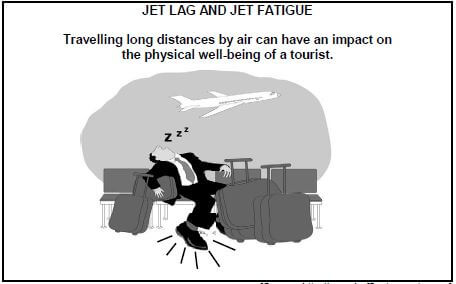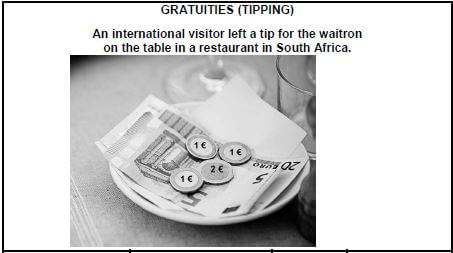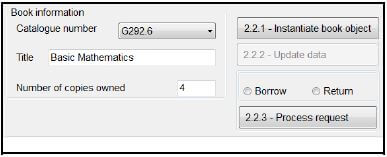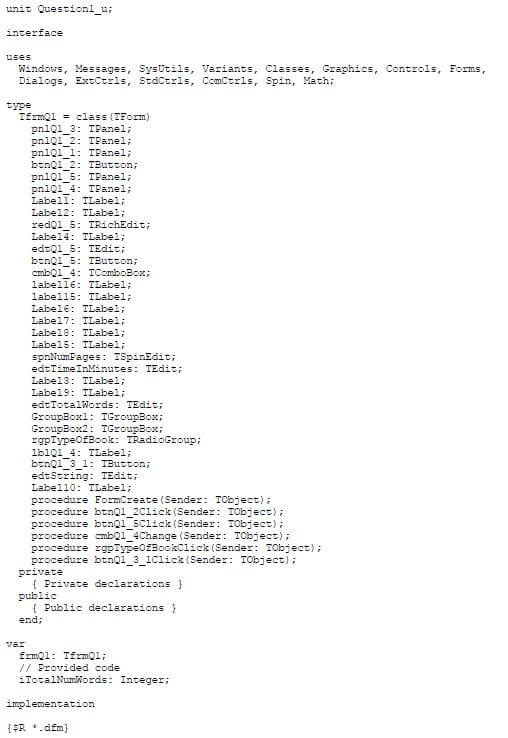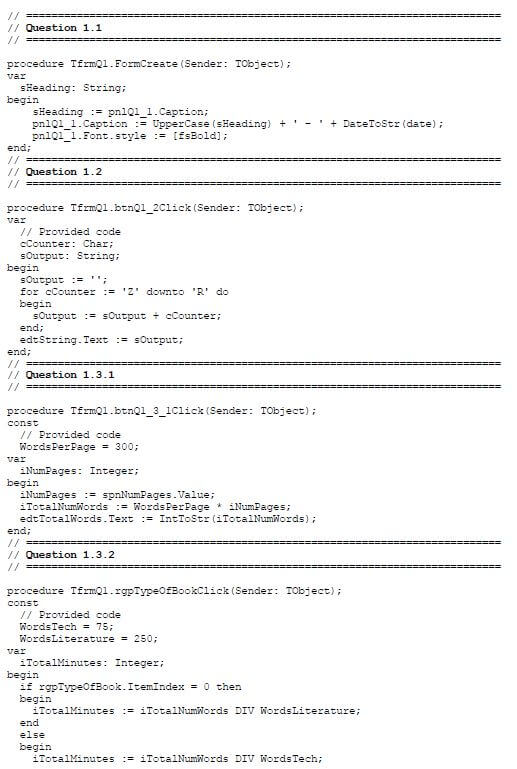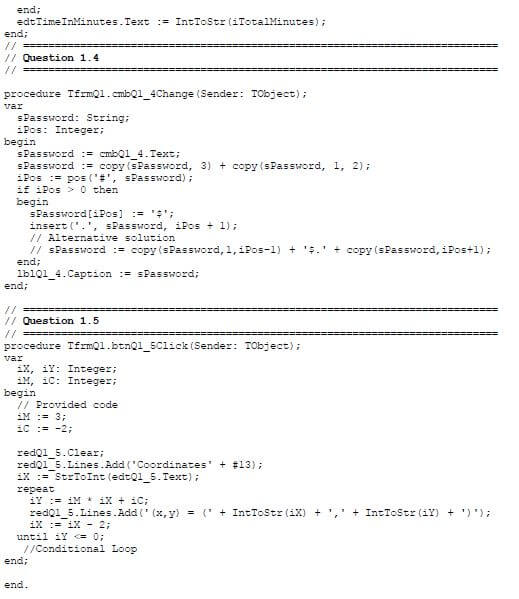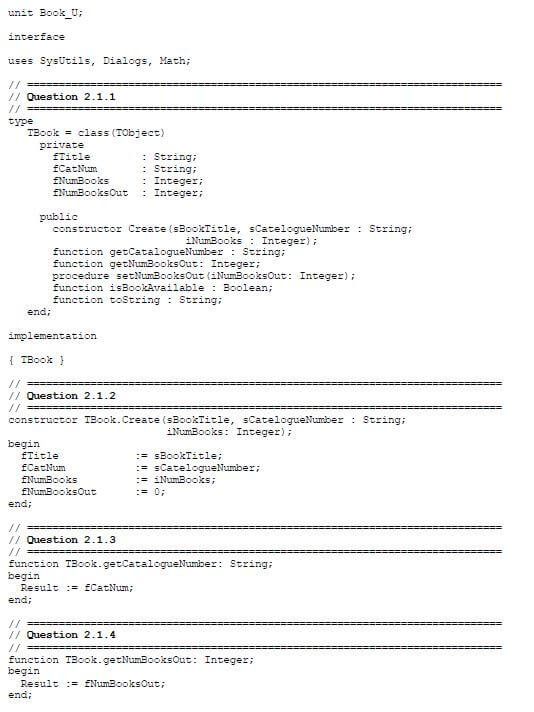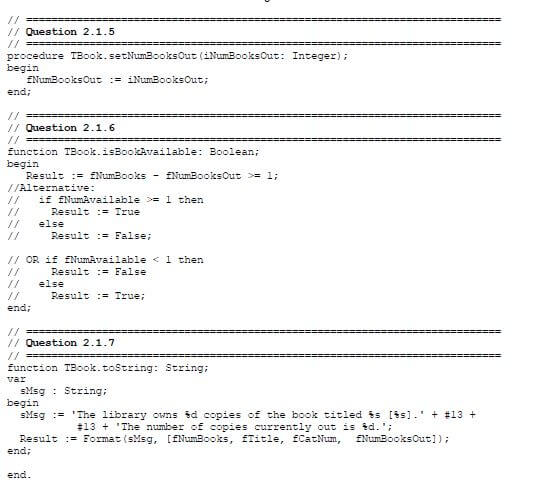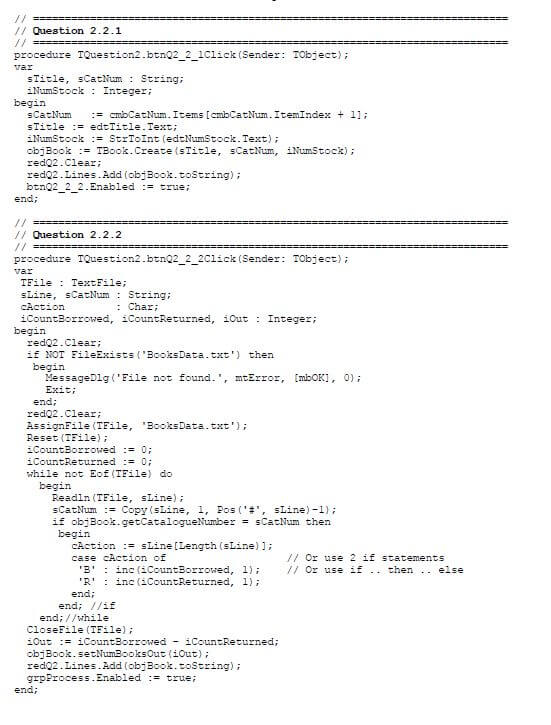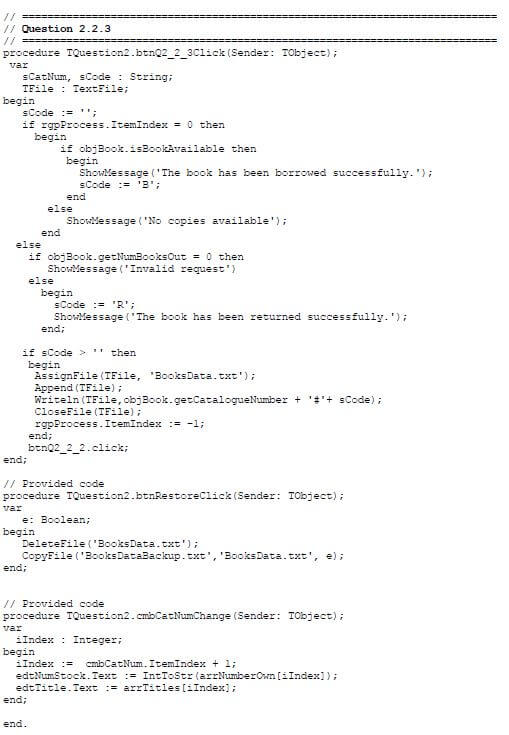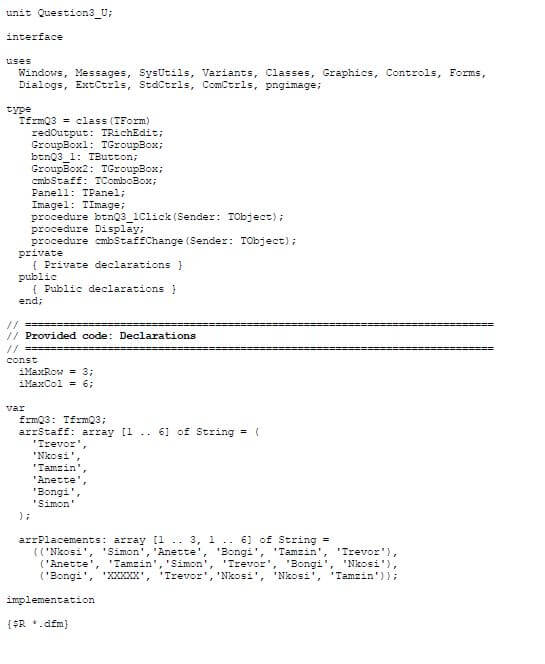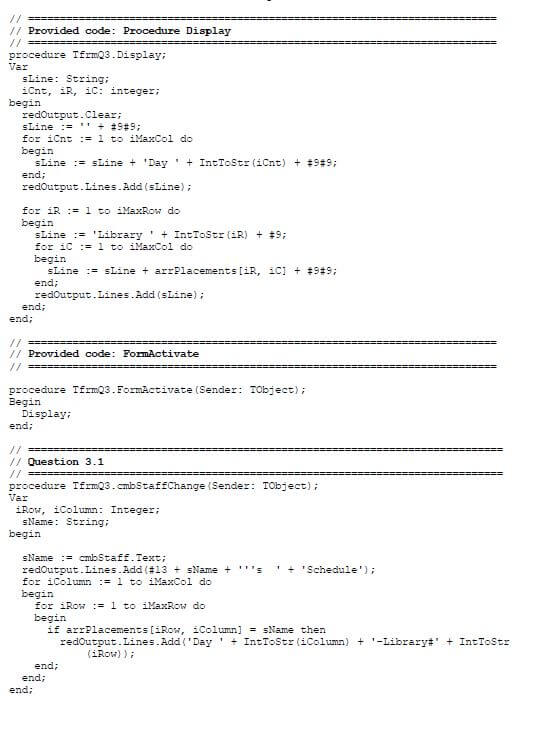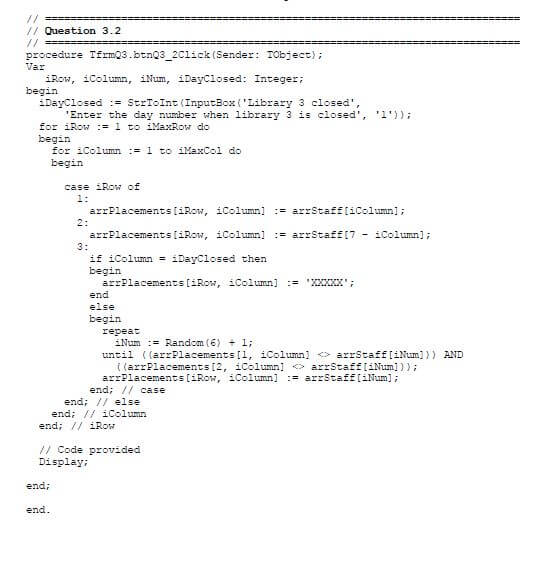Adele
MECHANICAL TECHNOLOGY GRADE 12 QUESTIONS - AMENDED SENIOR CERTIFICATE EXAMS PAST PAPERS AND MEMOS MAY/JUNE 2018
MECHANICAL TECHNOLOGY
GRADE 12
AMENDED SENIOR CERTIFICATE EXAMS
PAST PAPERS AND MEMOS
MAY/JUNE 2018
INSTRUCTIONS AND INFORMATION
- This question paper consists of TEN questions.
- Write your centre number and examination number in the spaces provided on the ANSWER BOOK.
- Read ALL the questions carefully.
- Answer ALL the questions.
- Number the answers correctly according to the numbering system used in this question paper.
- Start EACH question on a NEW page.
- Show ALL calculations and units. Round off ALL answers to TWO decimal places.
- Candidates may use non-programmable, scientific calculators and drawing instruments.
- Take the value of gravitational force as 10 m/s-2.
- All dimensions are in millimetres, unless stated otherwise in the question.
- A formula sheet for your use is attached to this question paper.
- Write neatly and legibly.
- Use the guidelines below to assist you in managing your time.
QUESTION | CONTENT | MARKS | TIME (minutes) |
1 | Multiple-choice questions | 20 | 15 |
2 | Safety | 10 | 10 |
3 | Tools and Equipment | 12 | 10 |
4 | Materials | 13 | 10 |
5 | Terminology | 30 | 20 |
6 | Joining Methods | 25 | 25 |
7 | Forces | 30 | 30 |
8 | Maintenance | 15 | 15 |
9 | Systems and Control | 25 | 25 |
10 | Turbines | 20 | 20 |
TOTAL | 200 | 180 | |
QUESTIONS
QUESTION 1: MULTIPLE-CHOICE QUESTIONS
Various options are provided as possible answers to the following questions. Choose the answer and write only the letter (A–D) next to the question number (1.1–1.20) in the ANSWER BOOK, for example 1.21 D.
1.1 What safety measure is applicable to the helical spring tester in terms of the Occupational Health and Safety Act, 1993 (Act 85 of 1993)?
- Make sure the spring is firmly in position.
- Use a hammer to remove the spring from the tester.
- Make sure that all contact surfaces between the compressor and the spring are well lubricated.
- Use wire to secure the spring in the tester. (1)
1.2 Which ONE of the following safety procedures applies to the gas analyser?
- Use water to remove dust from the exhaust system.
- Clean the gas inlet area with compressed air.
- Do not exceed the prescribed pressure in the tester.
- The work place must be well ventilated. (1)
1.3 Which ONE of the following equipment is used to test the compression in the cylinders of an internal combustion engine?
- Torsion tester
- Pressure tester
- Tensile tester
- Brinell tester (1)
1.4 Which property of material is determined with a Rockwell tester?
- Hardness
- Elasticity
- Tensile strength
- Brittleness (1)
1.5 What will be the result when steel is heated past the AC3 line?
- The grain structure will be at its finest.
- Steel will become brittle.
- It will start to lose magnetism.
- Steel will become a stronger magnet. (1)
1.6 Which ONE of the following is a property of ferrite?
- Brittle
- Soft
- Non-magnetic
- Hard (1)
1.7 What is the lead of a single-start metric V-screw thread with a pitch of 1,75 mm?
- 5,25 mm
- 3,5 mm
- 0,875 mm
- 1,75 mm (1)
1.8 What is a disadvantage of down-cut milling?
- The cutter blunts more rapidly.
- It cannot cut through thin pipes and tubes.
- A poor finish is produced.
- The coolant is not carried down to the teeth where it is required. (1)
1.9 How are welding defects observed when an X-ray test is performed on a welding joint? Welding defects are …
- visible on the weld.
- visible on film.
- determined by sound.
- visible on an oscilloscope screen. (1)
1.10 What is the purpose of applying a free-bend test on a welded joint?
- To detect internal defects
- To determine the hardness of the weld metal
- To detect external surface defects
- To determine the ductility of the weld metal (1)
1.11 What do you understand by the term stress in materials?
- External resistance in the material against an internal load
- External force in a material resisting an internal load
- Internal load caused by an external load
- Internal resistance in the material against an external load (1)
1.12 What does point D represents on the graph in FIGURE 1.12 below regarding the stress and strain? 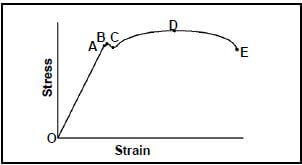
FIGURE 1.12
- The proportionality between the stress and strain
- The maximum stress in the material
- The minimum stress in the material
- The difference between the stress and strain (1)
1.13 What is understood by 1 Pascal stress in material?
- 1 Pascal is the moments caused by a force of 1 Newton onto an area of 1 m2.
- 1 Pascal is the energy used by a force of 1 Newton over a distance of 1 meter.
- 1 Pascal is the amount of stress caused by a force of 1 Newton onto an area of 1 m2.
- 1 Pascal is the amount of work done by a force of 1 Newton onto an area of 1 m2. (1)
1.14 SAE 80 oil is used for …
- gearbox lubrication.
- engine lubrication.
- automatic transmission lubrication.
- power steering lubrication. (1)
1.15 The definition of the viscosity index of oil is a measure of how much the oil's viscosity changes as the ... changes.
- temperature
- pressure
- flow
- resistance (1)
1.16 Which ONE of the following statements defines Boyle's law? An ideal gas law where, at …
- constant pressure, the volume of an ideal gas is inversely proportional to its absolute temperature.
- constant volume, the temperature of an ideal gas is inversely proportional to its absolute pressure.
- constant temperature, the volume of an ideal gas is inversely proportional to its absolute pressure.
- constant temperature, the volume of an ideal gas is proportional to its absolute pressure. (1)
1.17 What will the velocity ratio of a belt drive system be if the driven pulley rotates at 1 000 r/min and the driver pulley at 500 r/min?
- 1 : 5
- 5 : 1
- 1 : 2
- 2 : 1 (1)
1.18 Which ONE of the following is a disadvantage of a flat belt drive system compared to a gear drive system?
- Flat belts can be used over long distances.
- The length of flat belts can be shortened.
- Flat belts can be rejoined after it snapped.
- Flat belts needs to be cleaned regularly. (1)
1.19 Which method is used to drive a turbocharger?
- Chain drive
- Belt drive
- Exhaust gasses
- Gear drive (1)
1.20 Identify the type of turbine in FIGURE 1.20 below regarding the principle of operation. 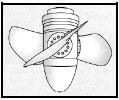
FIGURE 1.20
- Reaction turbine
- Extracting turbine
- Impulse turbine
- Induction turbine (1) [20]
QUESTION 2: SAFETY
2.1 Name any TWO pieces of personal safety equipment that you need to wear when working with an angle grinder. (2)
2.2 State THREE safety precautions you should observe before pressing a bearing from a shaft on a hydraulic press. (3)
2.3 Why is it important to wear an arc-welding helmet/shield during arc welding? (1)
2.4 State TWO safety precautions that should be adhered to before you start working on a milling machine. (2)
2.5 What safety aspect must be executed before leaving ANY machine after completing a given task? (1)
2.6 State ONE safety precaution you should observe when using a spring compressor to remove a coil spring from a motor vehicle's suspension. (1) [10]
QUESTION 3: TOOLS AND EQUIPMENT
3.1 Tools and equipment are very important to complete different tasks in the workplace. Explain the function of EACH of the following testing equipment:
3.1.1 Fuel pressure tester (2)
3.1.2 Torsion tester (2)
3.1.3 Cylinder leakage tester (2)
3.2 Give TWO reasons why it is necessary to perform a cylinder leakage test on an engine. (2)
3.3 Most welding companies use MIG/MAGS welding equipment for their welding.
3.3.1 State TWO advantages of the use of the MIG/MAGS welding process rather than the conventional arc welding process. (2)
3.3.2 Name TWO gasses used as inert gas in the MIGS/MAGS welding process. (2) [12]
QUESTION 4: MATERIALS
4.1 Define the term higher critical temperature in the heating of steel. (2)
4.2 FIGURE 4.2 below shows a diagram. Answer the questions that follow. 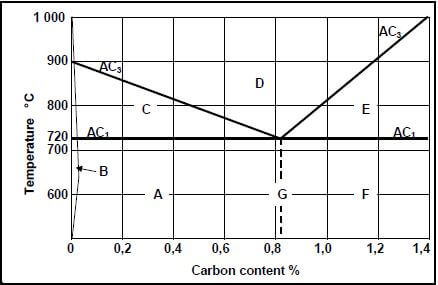
FIGURE 4.2
4.2.1 Identify the diagram shown in FIGURE 4.2 above. (2)
4.2.2 Label structures A to G. (7)
4.2.3 To what temperature should steel, with a carbon content of 1,2%, be heated for hardening? (2) [13]
QUESTION 5: TERMINOLOGY
5.1 A parallel key must be machined to fit onto a 84 mm diameter shaft. Calculate the following:
5.1.1 The width of the key (2)
5.1.2 The thickness of the key (2)
5.1.3 The length of the key (2)
5.2 A spur gear with 106 teeth must be cut on a milling machine. Calculate the simple indexing needed to cut this gear with the help of a Cincinnati dividing head. (3)
5.3 The pitch of a metric V-screw thread is 2 mm. Calculate the depth of the screw thread. (HINT: H = 0,866 P) (2)
5.4 A spur gear has 48 teeth and a module of 3. Calculate the following:
5.4.1 Addendum (1)
5.4.2 Dedendum (2)
5.4.3 Clearance (2)
5.4.4 Pitch-circle diameter (PCD) (2)
5.4.5 Outside diameter (2)
5.4.6 Cutting depth (2)
5.4.7 Circular pitch (2)
5.5 Identify the type of key shown in FIGURE 5.5 below. 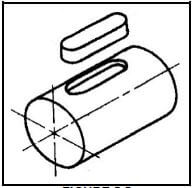
FIGURE 5.5 (2)
5.6 Identify the milling process shown in FIGURE 5.6 below. 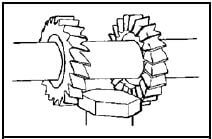
FIGURE 5.6 (2) 5.7 Identify the engineering equipment shown in FIGURE 5.7 below. 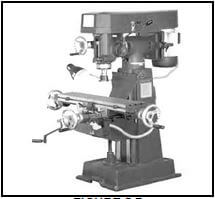
FIGURE 5.7 (2) [30]
QUESTION 6: JOINING METHODS
6.1 State ONE cause of EACH of the following welding defects:
6.1.1 Porosity (1)
6.1.2 Undercutting (1)
6.1.3 Slag inclusion (1)
6.2 Name THREE destructive tests that can be executed onto a welded joint. (3)
6.3 Describe how the dye penetration test is done on a welded joint. (6)
6.4 What is the purpose of the inert gas used during the MIG/MAGS welding process? (3)
6.5 State THREE factors that should be considered during the MIG/MAGS welding process. (3)
6.6 FIGURE 6.6 below shows the MIG/MAGS welding process. Label A to G. E 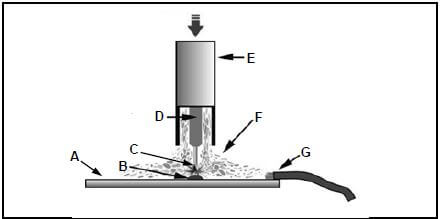
FIGURE 6.6 (7) [25]
QUESTION 7: FORCES
7.1 Four forces of are acting on the same point, as shown in FIGURE 7.1 below. Determine, by means of calculations, the magnitude and direction of the resultant of the system of forces in FIGURE 7.1. 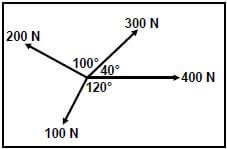
FIGURE 7.1 (13)
7.2 A load of 80 kN is exerted onto a brass bush with an outer diameter of 62 mm and an inner diameter of 50 mm. The original length of the bush is 100 mm. Young's modulus for brass is 90 GPa.
Calculate the:
7.2.1 Stress in the bar (5)
7.2.2 Strain (3)
7.2.3 Change in length (3)
7.3 FIGURE 7.3 below shows a uniform beam that is supported by two vertical supports, A and B. A uniformly distributed force of 80 N/m is exerted over the right half of the beam. Determine, by means of calculations, the magnitudes of the reactions in supports A and B. 
FIGURE 7.3 (6) [30]
QUESTION 8: MAINTENANCE
8.1 Why is it important to use oil with a higher viscosity in a manual transmission? (2)
8.2 Give the reason for using SAE20W50 oil in an internal combustion engine. (2)
8.3 Define the term pour point of a lubricant. (1)
8.4 State TWO properties of grease. (2)
8.5 State THREE maintenance measures for cutting fluid in a centre lathe or milling machine. (3)
8.6 Explain the effect when the viscosity of the oil used in an internal combustion engine is too low. (2)
8.7 Explain the reason for skimming the flywheel before installing a new clutch plate. (3) [15]
QUESTION 9: SYSTEMS AND CONTROL
9.1 FIGURE 9.1 below shows a gear drive system. Driver gear A on the shaft of the electric motor has 40 teeth that mesh with gear B with 60 teeth on a counter shaft. On the counter shaft is another driver gear, C, with 30 teeth that mesh with gear D with 80 teeth on the final driven shaft. 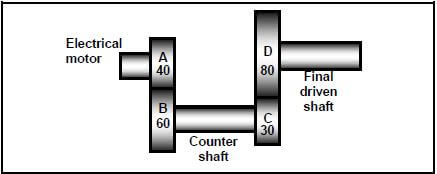
FIGURE 9.1
Calculate the:
9.1.1 Rotation frequency of the final driven shaft if the electrical motor rotates at 1 440 r/min (3)
9.1.2 Velocity ratio between the input and output shafts (2)
9.2 FIGURE 9.2 below shows a belt drive system with a 260 mm driver pulley. The belt speed of the system is 40 m.s-1. The tensile force in the slack side is 140 N and the ratio between the force in the tight side and the force in the slack side is 2,5. 
FIGURE 9.2
Calculate the:
9.2.1 Rotation frequency of the driver pulley in r/min (revolutions per minute) (3)
9.2.2 Power transmitted (5)
9.3 A hydraulic system is used to lift a machine. The specifications of the system are presented diagrammatically in FIGURE 9.3 below. 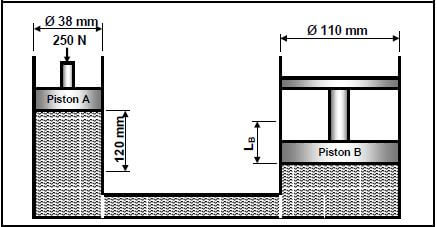
FIGURE 9.3
Calculate the:
9.3.1 Fluid pressure in the hydraulic system when in equilibrium (4)
9.3.2 Distance LB that Piston B will move with TEN strokes of Piston A (4)
9.4 State ONE advantage of the antilock braking system (ABS) in a motor vehicle compared to a system without ABS? (2)
9.5 Explain why the airbag safety system in a motor vehicle is referred to as an active safety feature. (2) [25]
QUESTION 10: TURBINES
10.1 Name TWO types of reaction turbines. (2)
10.2 Explain the operation of the impulse turbine. (6)
10.3 Why is it important to control the speed of a steam turbine? (2)
10.4 State THREE advantages of a gas turbine. (3)
10.5 What is the purpose of the waste gate in a turbocharger? (2)
10.6 What effect does a high altitude have on the performance of the engine of a motor vehicle? (2)
10.7 State ONE advantage of a turbocharger when compared to a supercharger. (1)
10.8 Identify the type of blower in FIGURE 10.8 used as a supercharger on an internal combustion engine. 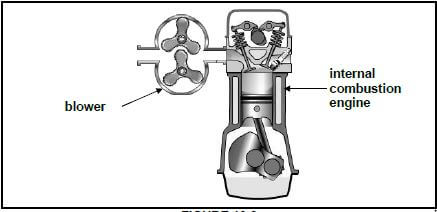
FIGURE 10.8 (2)
[20]
TOTAL: 200
FORMULA SHEET 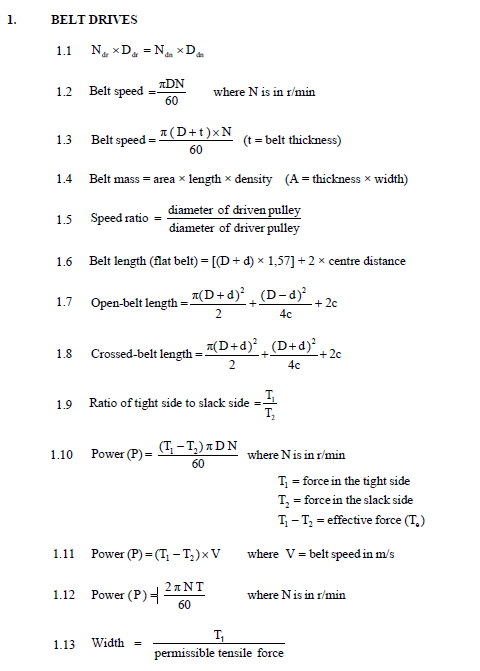
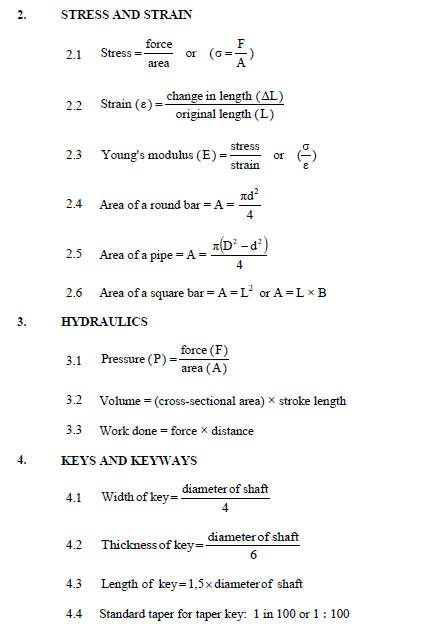
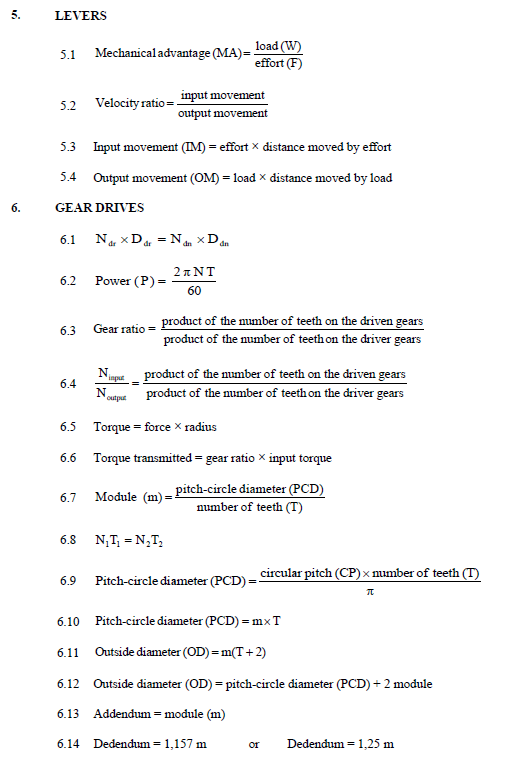
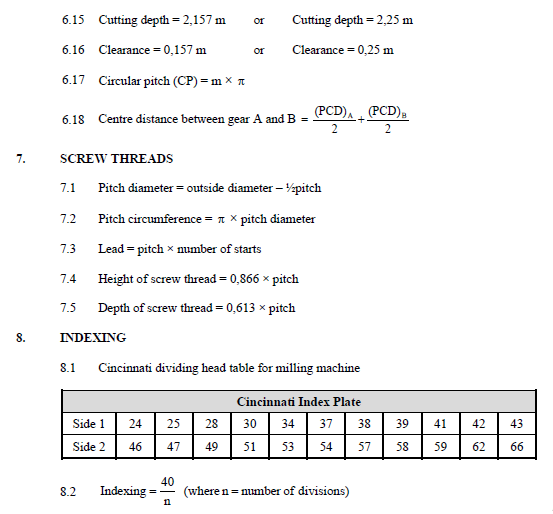
TOURISM GRADE 12 QUESTIONS - AMENDED SENIOR CERTIFICATE EXAMS PAST PAPERS AND MEMOS MAY/JUNE 2018
TOURISM
GRADE 12
AMENDED SENIOR CERTIFICATE EXAMS
PAST PAPERS AND MEMOS
MAY/JUNE 2018
INSTRUCTIONS AND INFORMATION
Read the instructions carefully before answering the questions.
- This question paper consists of FIVE sections.
- Answer ALL the questions.
- Start EACH question on a NEW page.
- In QUESTIONS 3.1 and 3.2, round off your answer to TWO decimal places.
- Show ALL steps for the calculations.
- You may use a non-programmable calculator.
- Use the mark allocation of each question as a guide to the length of your answer.
- Write neatly and legibly.
- The table below is a guide to help you allocate your time according to each section.
SECTION | TOPIC | MARKS | TIME (minutes) |
A | Short Questions | 40 | 20 |
B | Map Work and Tour Planning; Foreign Exchange | 50 | 50 |
C | Tourism Attractions; Culture and Heritage Tourism; Marketing | 50 | 50 |
D | Tourism Sectors; Sustainable and Responsible Tourism | 30 | 30 |
E | Domestic, Regional and International Tourism; Communication and Customer Care | 30 | 30 |
TOTAL | 200 | 180 |
QUESTIONS
SECTION A: SHORT QUESTIONS
QUESTION 1
1.1 Various options are provided as possible answers to the following questions. Choose the answer and write only the letter (A–D) next to the question numbers (1.1.1 to 1.1.20) in the ANSWER BOOK, for example 1.1.21 D.
1.1.1 The travel document attached to a passport allowing entry into a foreign destination.
- International driving license
- Tourist visa
- Yellow fever certificate
- Birth certificate
1.1.2 Good advice given to a tourist regarding safety in a foreign country:
- Always carry large amounts of cash.
- Display expensive camera equipment.
- Ensure visibility of room keys.
- Carry copies of travel documents.
1.1.3 Travel allowances are part of … regulations of a country.
- visa
- passport
- customs
- exchange
1.1.4 … fluctuations in the exchange rate will impact on outbound tourists who purchase foreign currency just before their international flights.
- Daily
- Monthly
- Quarterly
- Annual
1.1.5 The downgrading of South Africa's economic status by certain rating agents in 2017 resulted in …
- the strengthening of the value of the rand.
- a drop in the value of the United States dollar.
- an increase in the exchange rate of the rand.
- the economic recession in South Africa.
1.1.6 The icons found in France: 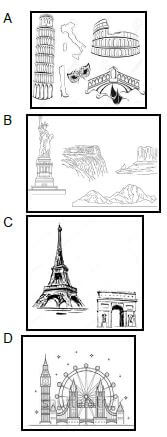
1.1.7 The highest mountain peak in the world which is part of the Himalayas:
- Mount Fuji
- Swiss Alps
- Mount Everest
- Ayers Rock
1.1.8 The country where the icon below is located: 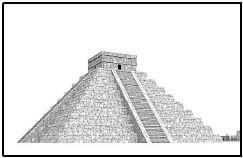
- Brazil
- Argentina
- Rio De Janeiro
- Mexico
1.1.9 The site where one of the largest genocides (mass killing of people) occurred during World War II:
- Berlin Wall
- Kremlin
- Auschwitz
- Red Square
1.1.10 A factor that contributes to Machu Picchu being a successful tourist attraction:
- Machu Picchu limits the number of tourists visiting the attraction.
- Tourists to Machu Picchu are offered free accommodation.
- Tourists on wheelchairs are not allowed to visit Machu Picchu.
- Machu Picchu does not advertise their tourist packages.
1.1.11 Human rights in the tourism industry can be explained as …
- steps taken during wage negotiations in the workplace.
- treating all individuals in a respectful and fair manner.
- a tourism company gaining economic benefits for itself.
- consumer responsibilities when shopping at the mall.
1.1.12 Responsible and sustainable tourism focuses on …
- carrying prohibited products while on holiday.
- promoting good international relationships and nation building.
- driving recklessly in a foreign country.
- saving and conserving resources for future generations.
1.1.13 Laura is a chef at a restaurant. The most appropriate dress code to accommodate her core duties would be: 
1.1.14 Compulsory information included in an employment contract:
- Previous employer
- Personal values
- Tax refunds
- Core duties
1.1.15 A factor that contributes to the professional image of a tourism business:
- Environmental policies
- Bereavement policies
- Retirement policies
- Procurement policies
1.1.16 The demand for tourism will decrease in destinations where there is an increase in …
- civilian conflict.
- customer loyalty.
- social investment.
- local procurement.
1.1.17 The full term/name for G8 in the 2016 logo below is … 
- Gulf eight leaders.
- German top eight economies.
- Great eight countries.
- Gifts from eight governments.
1.1.18 Cultural tourists would prefer these activities to be included in their itinerary when they visit Mpumalanga:
- Skiing and snow-boarding
- Game viewing and traditional dancing
- Going to the beach and snorkelling
- Swimming with dolphins and canoeing
1.1.19 By using a service delivery survey, the owner of a bed and breakfast establishment can establish the …
- number of tourists that will rent a car from them.
- property value in order to sell the business.
- satisfaction levels of guests at the establishment.
- occupancy rates charged by competitors in the industry.
1.1.20 A heading that describes the process in the flow diagram below: 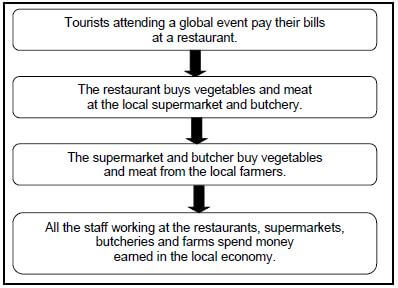
- Voluntary donation
- Economic upsets
- Global recession
- Multiplier effect (20 x 1) (20)
1.2 Give ONE word(s)/term for each of the following descriptions by choosing a word(s)/term from the list below. Write only the word(s)/term next to the question numbers (1.2.1 to 1.2.5) in the ANSWER BOOK.
Tower of London; Rio de Janeiro; equator; UNESCO; unforeseen event; UNWTO; UTC; Brazil; global sporting event; Eiffel Tower; latitudes |
1.2.1 The organisation responsible for gathering tourism statistics on global travel (1)
1.2.2 The crown jewels are associated with this icon (1)
1.2.3 The term used to describe the 2023 Rugby World Cup (1)
1.2.4 This imaginary line is also referred to as the 0° line of longitude (1)
1.2.5 The Statue of Christ the Redeemer is found in this country (1)
1.3 Choose the correct word from those given in brackets. Write only the word(s) next to the question numbers (1.3.1 to 1.3.5) in the ANSWER BOOK, for example 1.3.6 passport.
1.3.1 (Toiletries/Meals) are calculated as part of the budget compiled by a travel agent. (1)
1.3.2 According to SATourism, tourists arriving from Mauritius are regarded as South Africa's (air/land) source markets. (1)
1.3.3 The Wimbledon Tennis Tournament has a positive impact on the economy of (London/New York) as the host city. (1)
1.3.4 Passengers flying from east to west, crossing the IDL, will (gain/lose) a day. (1)
1.3.5 The 2018 COP24 is a conference on (service delivery/ climate change). (1)
1.4 Choose the picture from COLUMN B that matches the factors contributing to the success of an attraction in COLUMN A. Write only the letter (A–F) next to the question numbers (1.4.1 to 1.4.5) in the ANSWER BOOK, for example 1.4.6 K
COLUMN A | COLUMN B |
1.4.1 Crime prevention | 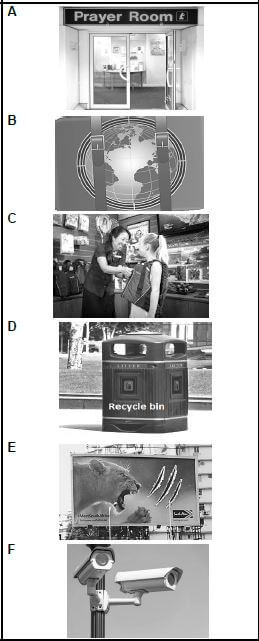 |
(5 x 1) (5)
1.5 Study the 'Frequently Asked Questions' page of the TOMSA booklet below.
Match the answers (in the block below) to the 'Frequently Asked Questions'. Write only the answer next to the question numbers (1.5.1 to 1.5.5) in the ANSWER BOOK, e.g. 1.5.6 accommodation.
| marketing; 1%; 80%; SATourism; tourists; accommodation establishments; airlines; compulsory; voluntary; FTT |
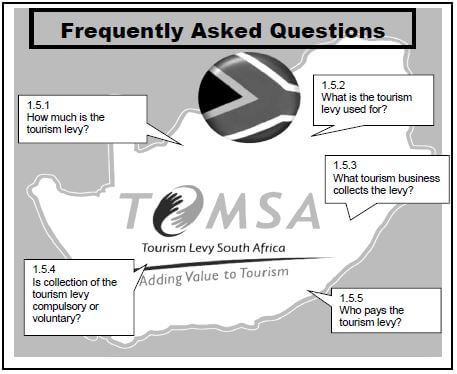 (5)
(5)
TOTAL SECTION A: 40
SECTION B: MAP WORK AND TOUR PLANNING, FOREIGN EXCHANGE
QUESTION 2
2.1 Study the World Time Zone map below, read the information and answer the questions that follow. 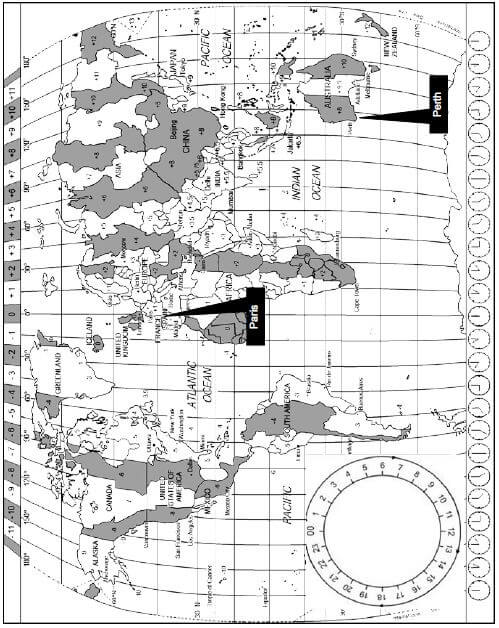
THE 2019 FIFA WOMEN'S WORLD CUP South African soccer fans will fly to Paris, France, to watch some of the World Cup matches. They will depart from OR Tambo International Airport at 20:00 on Wednesday, 5 June 2019. Their total flying time will be 11 hours. They will remain in France for the duration of the World Cup. Thereafter they will spend a few days in three north-eastern European countries that share borders with France. |
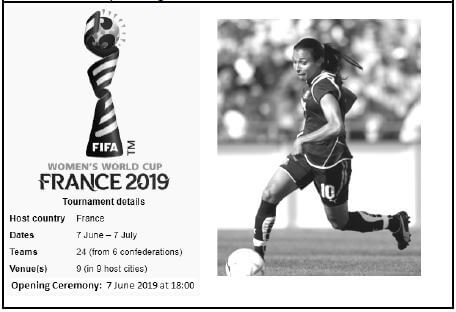 |
2.1.1 Name the visa that South Africans will have to apply for to enter France. (1)
2.1.2 List THREE supporting documents that must be submitted with the application for the visa in QUESTION 2.1.1. (3)
2.1.3
- Calculate the time at which the viewers in Perth, Australia, will be able to watch the opening ceremony live on television. (5)
- Calculate the time at which the South African fans will arrive in Paris, France.
NOTE: Show ALL calculations. (7)
DAYLIGHT SAVING TIME Daylight saving time 2019 in France starts at 02:00 on Sunday 31 March and will end at 03:00 on Sunday 27 October. |
2.2
2.2.1 Explain ONE reason why South African soccer fans who will attend the World Cup have to be aware of DST in their travel planning. (2)
2.2.2 Explain TWO time-related benefits for South African fans while they are at the 2019 FIFA Women's World Cup in Paris. (4)
2.3 Study the map below and answer the questions that follow.
The soccer fans from South Africa want to extend their stay in Europe after the 2019 FIFA Women's World Cup. They plan to visit THREE countries in the north-east of Europe that share borders with France. They are going use the Eurorail to travel to these countries. |
MAP OF COUNTRIES BORDERING FRANCE |
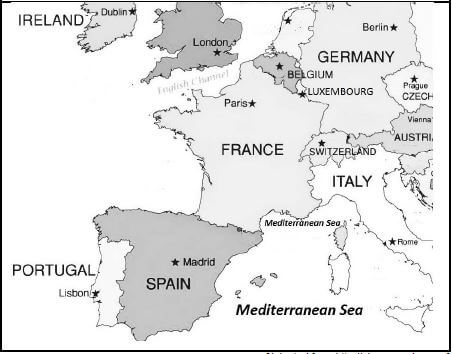 |
[Adapted from http://nissanmaxima.me]
2.3.1 Logical route planning is an important consideration for international travel.
Select THREE countries in north-eastern Europe which share a border with France, that the South Africans may choose to visit.
Write only the question number and the names of the countries. (3)
2.3.2 Name the bordering country that does NOT use the euro as its currency. (1)
2.4 Study the picture below and answer the questions that follow.
JET LAG AND JET FATIGUE |
[Source: http://www.huffingtonpost.co.za]
2.4.1 Explain the difference between jet lag and jet fatigue. (4)
2.4.2
- Refer to the picture and give TWO symptoms of jet lag. (4)
- State TWO ways in which the symptoms given in QUESTION 2.4.2(a) can be minimised. (4) [38]
QUESTION 3
3.1 Study the picture and the exchange rate table below and answer the questions that follow.
GRATUITIES (TIPPING) | |||
COUNTRY | CURRENCY CODE | BBR | BSR |
United Kingdom | GBP | 16.00 | 16.06 |
European countries | EUR | 13.60 | 13.70 |
3.1.1 Identify the currency that was left on the table for the waitron. (1)
3.1.2
- Add the total value of the foreign currency notes and coins left on the table. (1)
- Calculate how much the waitron could expect in rand when the owner of the restaurant exchanges the currency on behalf of the waitron. (3)
3.2 A British tourist left 27 British pounds on the table for the waitron.
3.2.1 Calculate the amount the waitron received in rand. Show ALL calculations and round off your answer to TWO decimal places. (3)
3.2.2
- Compare the two scenarios above in terms of the value of the tips the waitron has received. (2)
- Explain how the gratuities (tips) received by the waitron can add to the multiplier effect in the nearby community. (2) [12]
TOTAL SECTION B: 50
SECTION C: TOURISM ATTRACTIONS; CULTURE AND HERITAGE TOURISM; MARKETING
QUESTION 4
4.1 Refer to the clues below and complete the crossword puzzle.
Write only the answer next to the question numbers (4.1.1 to 4.1.6) in the ANSWER BOOK, for example 4.1.7 Eiffel Tower. 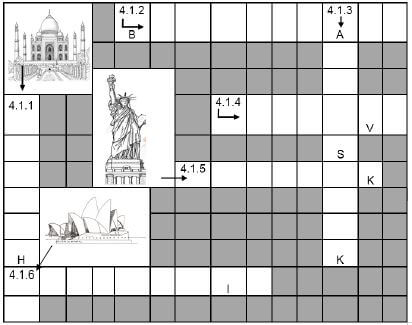
CLUES
DOWN | ACROSS |
4.1.1 Built in memory of the sultan's wife 4.1.3 Tourist attraction also called Uluru | 4.1.2 The structure demolished (broken down) to symbolise the fall of communism 4.1.4 Icon in Portugal 4.1.5 City where this statue is located 4.1.6 Country where this multi-art centre is located |
(6 x 1) (6)
4.2 Read the article below and answer the questions that follow.
FINDERS KEEPERS? Five thousand artefacts* excavated (taken from the ground) at Machu Picchu many years ago, have been kept at Yale University's museum in the USA. This was because when it was first discovered, Yale University bought the ownership rights of the artefacts from the Peruvian government in the 1900s. [Adapted from www.kimmacquarrie.com/peru-yale] |
4.2.1 Name the ancient cultural group associated with Machu Picchu. (1)
4.2.2 Name the continent where Machu Picchu is located. (1)
4.2.3 Explain why this icon was built. (2)
4.2.4 This icon was discovered high up in the Peruvian mountains. Discuss ONE reason why this cultural group would have chosen to live so high up in the mountains. (2)
4.2.5 Identify TWO ways in the article in which the Peruvian government is trying to revive the importance of this icon. (4)
4.2.6 In a paragraph, explain the disagreement surrounding the artefacts of Machu Picchu.
Your paragraph should focus on the following:
- A discussion on the disagreement between Yale and Peru surrounding the icon. (2 x 2)
- ONE argument in favour of Peru's point of view. (2)
NOTE: ONE mark will be awarded for paragraph format containing complete, well-constructed sentences without bullets or numbers. (1) (7) [23]
QUESTION 5
Study the information board below and answer the questions that follow. 
[Adapted from www.unesco.org]
5.1 State the type of World Heritage Site shown on the information board. (1)
5.2 Name the province where the site in QUESTION 5.1 is located. (1)
5.3 Give ONE reason why the UNESCO logos appear on the information board. (2)
5.4 On the information board above UNESCO states, 'These works are illustrative of the evolution of human society and settlement over time …'
Suggest TWO characteristics of this site which illustrates the evolution of human society. (4)
5.5 Explain TWO ways in which this site has global significance for future generations. (4) [12]
QUESTION 6
Study the information taken from the TOMSA booklet below and answer the questions that follow.
Our Initiatives:
|
6.1 Name the organisation represented in the logo. (1)
6.2 State TWO ways in which the Tourism Safety Initiative will benefit tourism businesses. (4)
6.3 From the information, identify the following:
6.3.1 ONE public entity that partners with South Africa's marketing body to grow and develop the tourism industry in South Africa (1)
6.3.2 ONE organisation that partners with South Africa's marketing body to grow and develop the tourism industry in South Africa (1)
6.4 Discuss TWO ways how tourism businesses will benefit from the initiatives in the article. (4)
6.5 Name the following:
6.5.1 The international travel trade show in Germany where South Africa is marketed (1)
6.5.2The local travel trade show in Durban (1)
6.6 Give TWO examples of e-marketing used to market South Africa as a destination of choice. (2) [15]
TOTAL SECTION C: 50
SECTION D: TOURISM SECTORS; SUSTAINABLE AND RESPONSIBLE TOURISM
QUESTION 7
Study the pictures of employees at a travel agency below and answer the questions that follow. 
7.1 Explain the importance of a code of conduct at a travel agency. (2)
7.2 Discuss TWO ways in which the unprofessional behaviour of the staff members in the pictures above can impact negatively on the work ethics of the other staff members at the travel agency with regard to:
7.2.1 Harassment (4)
7.2.2 Laziness (4)
7.3 Explain TWO ways in which the employer can deal effectively with the above cases of unprofessional behaviour to ensure productivity at the travel agency. (4) [14]
QUESTION 8
Read the extract below and answer the questions that follow.
THE 'SWOP SHOP' – HELPING CHILDREN TO CARE Tourist visiting Gansbaai for shark cage diving are encouraged to visit the Gansbaai White Shark Swop Shop.
The White Shark Swop Shop CSI initiative combines conservation, social improvement and education in a unique way. [Adapted from www.whitesharkproject.co.za] |
8.1
8.1.1 From the above extract it is clear that the primary focus of the White Shark project is on the environmental and social pillar of sustainable tourism. Identify ONE example of how the economic pillar is being practised at the Swop Shop. (2)
8.1.2 Explain THREE ways, from an economic perspective, in which the White Shark Swop Shop project organisers empower the children of Masekhane to develop into self-sufficient individuals. (6)
8.2 Read the slogan below and answer the questions that follow.
RESPONSIBLE TRAVEL: |
Suggest TWO ways in which tourists can 'put back into travel what they get from it' by:
8.2.1 Supporting the local community (4)
8.2.2 Protecting the environment (4) [16]
TOTAL SECTION D: 30
SECTION E: DOMESTIC, REGIONAL AND INTERNATIONAL TOURISM; COMMUNICATION AND CUSTOMER CARE
Read the newspaper article below and answer the questions that follow.
FIVE FORMER PRESIDENTS OF THE UNITED STATES OF AMERICA RAISE FUNDS AFTER DEVASTATING HURRICANES The five living former US presidents appeared together on stage at a fundraiser event. [Adapted from www.theguardian.com] |
9.1
9.1.1 Give a description of a hurricane. (2)
9.1.2 Discuss TWO reasons why part of the money raised by the former presidents should be spent on tourism infrastructure in areas affected by the hurricanes. (4)
9.2
In recent years South Africa has had its own share of natural disasters, such as the devastating wildfires in Knysna during 2017. |
Suggest THREE ways in which the tourism industry in Knysna could recover from the wildfire disaster. (6)
9.3 Study the information below and answer the questions that follow.
JOHANNESBURG COMES UP TOPS According to MasterCard, Johannesburg was the most visited destination city out of 13 cities in Africa for the fourth year in 2016. | ||
2015 | 2016 | YEAR-ON-YEAR GROWTH |
3,39 million visitors | 3,6 million visitors | 6,2% increase |
The top source markets to Johannesburg, visitor volumes and expenditure are given in the table below. | ||
TOP 5 CITIES FROM WHERE JOHANNESBURG'S VISITORS CAME IN 2016 | ESTIMATED INTERNATIONAL OVERNIGHT VISITOR VOLUMES | INTERNATIONAL VISITOR EXPENDITURE IN US DOLLAR |
1. London (United Kingdom) | 373 000 | USD285 million |
2. Harare (Zimbabwe) | 294 000 | USD106 million |
3. Frankfurt (Germany) | 233 000 | USD84 million |
4. Maputo (Mozambique) | 185 000 | USD41 million |
5. Paris (France) | 163 000 | USD155 million |
[Adapted from www.newsroom.mastercard.com]
9.3.1 Name the company that compiled the statistics in the information above. (1)
9.3.2 Give the payment method associated with the company in QUESTION 9.3.1. (2)
9.3.3
- State whether the top 5 source markets are ranked according to visitor volumes or expenditure. (1)
- Give ONE reason for the answer to QUESTION 9.3.3(a). (2)
9.3.4 Identify the following markets:
- The market with the lowest expenditure (1)
- The market with the highest expenditure (1)
9.3.5 State ONE way in which city of Johannesburg can increase the spending patterns of markets with the lowest expenditure. (2) [22]
QUESTION 10
Read the article below and answer the questions that follow.
HOTELS MUST MANAGE THEIR ONLINE REPUTATIONS Most tourists read online reviews as part of their trip planning. They visit websites from where reviews and ratings are listed alongside rates and booking options. [Adapted from www.reknown.com] |
10.1 State ONE way in which customer feedback influences travel planning. (2) 10.2 Suggest ONE way in which a hotel should respond to the following:
10.2.1 A positive online review about the hotel (2)
10.2.2 A negative online review about the hotel (2)
10.3 Explain ONE reason why responding to online reviews in QUESTION 10.2 is a way of managing a hotel's online reputation. (2) [8]
TOTAL SECTION E: 30
GRAND TOTAL: 200
TOURISM GRADE 12 MEMORANDUM - AMENDED SENIOR CERTIFICATE EXAMS PAST PAPERS AND MEMOS MAY/JUNE 2018
TOURISM
GRADE 12
AMENDED SENIOR CERTIFICATE EXAMS
PAST PAPERS AND MEMOS
MAY/JUNE 2018
TOPICS IN THE TOURISM CAPS | ABBREVIATION | |
Topic 1 | Tourism sectors | TS |
Topic 2 | Map work and tour planning | MTP |
Topic 3 | Tourism attractions | TA |
Topic 4 | Sustainable and responsible tourism | SR |
Topic 5 | Domestic, regional and international tourism | DRI |
Topic 6 | Culture and heritage tourism | CH |
Topic 7 | Foreign exchange | FX |
Topic 8 | Communication and customer care | CC |
Topic 9 | Marketing | M |
MEMORANDUM
SECTION A: SHORT QUESTIONS
QUESTION 1
1.1
1.1.1 | B✓/Tourist visa | MTP |
1.1.2 | D✓/Carry copies of travel documents | MTP |
1.1.3 | C✓/customs | MTP |
1.1.4 | A✓/Daily | MTP |
1.1.5 | D✓/the economic recession in South Africa | FX |
1.1.6 | C✓/Eiffel Tower | TA |
1.1.7 | C✓/Mount Everest | TA |
1.1.8 | D✓/Mexico | TA |
1.1.9 | C✓/Auschwitz | TA |
1.1.10 | A✓/Machu Picchu limits the number tourists visiting the attraction | TA |
1.1.11 | B✔/treating all individuals in a respectful and fair manner | TS |
1.1.12 | D✔/the saving of resources for future generations | SR |
1.1.13 | A✔/chef's uniform | TS |
1.1.14 | D✔/core duties | TS |
1.1.15 | A✔/Environmental policies | TS |
1.1.16 | A✔/civilian conflict | DRI |
1.1.17 | C✔/Great eight countries | DRI |
1.1.18 | B✔/Game viewing and traditional dancing | DRI |
1.1.19 | C✔/satisfaction level of guests at the establishment | CC |
1.1.20 | D✔/Multiplier effect | DRI |
(20 x 1) [20]
1.2
1.2.1 | UNWTO✔ | MTP |
1.2.2 | Tower of London✔ | TA |
1.2.3 | global sporting event✔ | DRI |
1.2.4 | UTC✔ | MTP |
1.2.5 | Brazil✔ | DRI |
(5)
1.3
1.3.1 | Meals✔ | DRI |
1.3.2 | air✔ | DRI |
1.3.3 | London✔ | DRI |
1.3.4 | gain ✔ | DRI |
1.3.5 | climate change ✓ | DRI |
(5)
1.4
1.4.1 | F✔ | TA |
1.4.2 | D✔ | TA |
1.4.3 | E✔ | TA |
1.4.4 | A✔ | TA |
1.4.5 | C✔ | TA |
(5)
1.5
1.5.1 | 1%✔ | M |
1.5.2 | marketing✔ | M |
1.5.3 | accommodation establishments✔ | M |
1.5.4 | voluntary✔ | M |
1.5.5 | tourists✔ | M |
(5)
TOTAL SECTION A: 40
SECTION B: MAP WORK AND TOUR PLANNING; FOREIGN EXCHANGE
QUESTION 2
2.1
2.1.1 Schengen ✔ Visa
- French Schengen Visa MTP (1)
2.1.2 Valid passport✓
Bank statements / proof of sufficient funds ✓
Proof of employment✓ MTP (3)
- Proof of accommodation
- Proof of residence
- Paid flight ticket
- Proof of travel insurance
- Completed visa application form
- Letter of invite
- Unabridged birth certificate (for minors)
- Letter of consent from parents (for minors)
Note: Do not accept “passport” only.
2.1.3 (a)
France +1 Perth +8 | |
Time difference | = 7 hours✔ |
Opening ceremony in Perth | = 18:00 (+✔) 7 hours |
= 01:00✓ | |
DST in France: | = 01:00 (-✔)1hour DST = 00:00✔ |
OR | |
Alternative method
France +1 Perth +8 | |
DST in France: | +1 (+1✔) hour DST |
OR | |
MTP (5)
(b)
South Africa +2 France +1 | |
Time difference | = 1 hour✔ |
OR | |
MTP (7)
Alternative method
| South Africa +2 France +1 MTP | |
Add DST in France | +1 (+1 hour DST)✔ |
OR | |
2.2
2.2.1 France is practising DST, thus moving clocks one hour ahead. Therefore, there is no time difference between the two countries.✓✓
- France is practising DST and both countries will be (+2) from UTC.
- France is practising DST during this period, both countries will have the same time. MTP (2)
2.2.2 The fans do not have to adjust their watches to the local time.✓✓ The fans do not have to consider time differences when calling home.✓✓
- Business operating hours in both countries would be the same. MTP (4)
2.3
2.3.1 Belgium ✓ MTP (1) Luxembourg ✓ (1) Germany ✓ (1)
- Switzerland
- Italy
NOTE: Accept any combination of three countries that share borders with France, where rail can be used as a mode of transport.
2.3.2 Switzerland✓ MTP (1)
2.4
2.4.1 Jet Lag: Long distances crossing multiple time zones
Jet lag is caused by crossing multiple time zones travelling from east to west and vice versa on long haul flights. ✔✔
- Interference with the natural rhythm of the body due to crossing multiple time zones.
Jet Fatigue: Long distances (no or few time zones)
Jet fatigue is caused by travelling long distances on long haul flights crossing no or only a few time zones. ✔✔
- General tiredness of the body due to a long haul flight. MTP (4)
2.4.2
- Fatigue/tiredness/sleepiness✔✔
Swollen legs and feet✔✔- Disorientation/confusion
- Interruption of sleeping patterns/lack of sleep
- Aching muscles
- Headaches
- Loss of appetite MTP (4)
- Use sleeping aids - Blindfolds, ear plugs, neck rests and blow up pillows are useful in getting quality sleep while flying✔✔
Get enough exercise during the flight ✔✔- Limit the use of alcohol/heavy meals
- Get enough sleep before departure
- Shower during stopovers
- Drinking enough water during the flight MTP (4) [38]
QUESTION 3
3.1
3.1.1 Euro✔
- EUR
- € FX (1)
3.1.2
- 30 Euros ✔
- 30 (x✓) (13.60✓) = ZAR 408.00✓ FX (1) (3)
3.2
3.2.1 27 (x✓) (16.00✓) = ZAR 432.00✓ FX (3)
3.2.2
- He received more value in rand from the British tourist than the European tourist. ✔✓
- The amount he received in tips in euro was more than the amount in tips he received in British pounds. FX (2)
- The gratuities received by the waitron set the multiplier effect in motion and gives the waitron more spending power in the local community, benefitting many business and households. ✔✔
Note: Accept examples related to the application of the multiplier effect FX (2) [12]
TOTAL SECTION B: 50
SECTION C: TOURISM ATTRACTIONS; CULTURE AND HERITAGE TOURISM; MARKETING
QUESTION 4
4.1
4.1.1 Taj Mahal✓ TA
4.1.2 Berlin Wall✓ TA
4.1.3 Ayers Rock✓ TA
4.1.4 Algarve✓ TA
4.1.5 New York✓ TA
4.1.6 Australia✓ TA (6)
OR 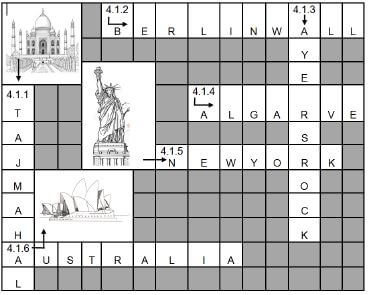
4.2
4.2.1 Incas✓ TA (1)
4.2.2 South America✓ TA (1)
4.2.3 It was built as a city for human settlement. ✓✓ TA (2)
4.2.4 It would have been built high up in the mountains as a protective measure against other invading forces. ✓✓
- The height of the mountains would have had a religious significance and therefore the positioning at the top of the mountains. TA (2)
4.2.5
- They have renovated and upgraded their museum near Machu Picchu. ✓✓
- They are trying to get the artefacts back from Yale University. ✓✓
- They threatened a lawsuit against Yale University if they do not return the artefacts. TA (4)
4.2.6
- The disagreement surrounding the icon between Yale and Peru mentioned in the article.
The Peruvians believe that they are the rightful owners of the artefacts as it was found in their country. ✔✔
Yale University believes they are the legal owners of the artefacts as they were the ones who bought the right to it from the Peruvian government. ✔✔ - The issue is over ownership of the artefacts. TA (4)
Note: Two perspectives must be indicated – one from the Peruvian government and one from Yale university.
ONE argument in favour of Peru's point of view
It is part of the Peruvian's ancient heritage and needs to be protected and sustained for their future generations. ✓✓
- At the time it was found, the Peruvians lacked knowledge on the value of the artefacts.
- They did not know about ownership rights.
- It is unfair to hold them now to something they had little or no knowledge about. (2)
Paragraph format
Complete well-constructed sentences were used, written as a complete paragraph without bullets or numbers. ✓ (1) [23]
QUESTION 5
5.1 Cultural World Heritage Site✓
- Cultural CH (1)
5.2 Limpopo✓ CH (1)
5.3 UNESCO was responsible for declaring the site a World Heritage Site. ✓✓
- It is inscribed as a World Heritage Site by UNESCO
- UNESCO is the controlling body of this site.
- UNESCO can be contacted with regards to the site
- Gives the site status and credibility CH (2)
5.4 Evidence of an early human settlement in the form of a kingdom including palaces was discovered. ✔✔
An advanced early civilisation with evidence of iron age tools and artefacts showing economic prosperity. ✓✓
- Evidence of trading as an economic activity. CH (4)
5.5 The future generations will earn an income from tourist guiding or other economic activities at Mapungubwe Cultural Landscape. ✓✓
It traces the history of human development from iron age to present age enabling the future generations to reflect on the past and prepare for the future. ✓✓
- It can be used as a resource for scientific study by the future generations and development of skills. CH (4) [12]
QUESTION 6
6.1 South African Tourism✔
- SATourism M (1)
6.2 Addressing tourist safety in South Africa, will increase the number of tourists to the country.✔✔
Change negative perceptions about the crime in SA and thereby increase profits of tourism businesses. ✔✔ M (4)
6.3
6.3.1 South African Police Services✓
- SAPS
- Police services M (1)
6.3.2 TBCSA✓
- Tourism Business Council of South Africa M (1)
6.4 The money collected from the levy is used to support and grow tourism in South Africa. ✔✔
Strengthening the potential of tourism businesses.✔✔
- It offers incentives for tourism businesses.
- It provides viable platforms for marketing and networking opportunities for tourism businesses. M (4)
6.5
6.5.1 ITB✓ M (1)
6.5.2 INDABA✓ M (1)
6.6 Social media platforms ✓
Television ✓
- Radio broadcasts
Note: Accept examples of social media platforms M (2) [15]
TOTAL SECTION C: 50
SECTION D: TOURISM SECTORS; SUSTAINABLE AND RESPONSIBLE TOURISM
QUESTION 7
7.1 It guides employees on acceptable behaviour at the workplace to maintain order.✔✔
- To ensure that the company's operations run smoothly and the company remains profitable.
- It is used by the travel agency to defend themselves in cases of legal action by employees. TS (2)
7.2 7.2.1 Increase in resignations resulting in additional recruiting, hiring and training costs for the company. ✔✔
Increased absenteeism resulting in decreased production. ✔✔
- Reduced productivity from employees, as a loss of motivation will lead to no extra effort or extended working hours.
- Poor service delivery to clients owing to disruptions when dealing with staff complaints.
- Poor employee relationships. TS (4)
7.2.2 Low productivity levels amongst staff members.✔✔
They easily influence co-workers to adopt their same poor work ethics. ✔✔
- Other employees will have to carry the extra workload.
- These employees will not be able to function effectively within a team
- Creates feelings of animosity (bitterness) amongst employees. TS (4)
7.3 Refer the employees to the code of conduct. ✔✔
Should the behaviour not improve, gather evidence on the unprofessional behaviour, in order to take it to the next level of intervention.✔✔
- Set up a meeting with the offenders to discuss and resolve their unprofessional behaviour.
- Termination of services in severe cases. TS (4)
NOTE: Accept examples of different types of interventions.
QUESTION 8
8.1
8.1.1 Swopping points for goods✔✔
- trading SR (2)
8.1.2 Teaching them trading skills. ✔✔
Teaching them to save to be able to afford their basic living expenses.✔✔
Teaching them to make responsible choices in life. ✔✔
- Teaching them to practice sustainable living by earning an income. SR (6)
8. 2
8.2.1 Buy locally made handcrafts and products.✔✔
Respect the livelihood of local vendors by paying fair prices for their products.✔✔
- Do not buy counterfeit (fake) products/ items prohibited by the destination's laws and regulations.
- Support local businesses.
- Empowering the local community to be self-sufficient. SR (4)
Note: Accept specific examples of ways to support local communities.
8.2.2 Reducing water and energy consumption whenever possible.✔✔ Leave only a minimum footprint (no littering).✔✔
- Respecting wildlife in their natural habitats.
- Purchasing products that are not made from endangered plants or animals.
- In protected areas, accessing only places that are open to visitors.
- Remaining on designated hiking trails.
- Make donations to support conservation programmes.
- Volunteering in environmental projects.
- Recycle, Reduce and Re-use SR (4) [16]
TOTAL SECTION D: 30
SECTION E: DOMESTIC, REGIONAL AND INTERNATIONAL TOURISM; COMMUNICATION AND CUSTOMER CARE
QUESTION 9
9.1
9.1.1 A hurricane is a natural disaster in the form of tropical storms with extreme wind, rain and weather conditions. ✔✔
- Tropical storms that cause damage to the environment and loss of life
- It is an unforeseen natural disaster. DRI (2)
9.1.2 The transport infrastructure (roads, airports, railway lines etc.) necessary for tourists to travel to the area needs to be repaired and rebuilt. ✔✔
Accommodation infrastructure that was damaged needs to be reconstructed. ✔✔
- Funds are needed to repair damage to attractions in the affected areas.
- The telecommunication and power networks need to be restored for the tourism industry to function optimally. DRI (4)
9.2 Encouraging and promoting existing tourism events to generate income from the tourism industry for example the Oyster Festival. ✔✔ Knysna was declared a disaster area by the government and as a result received extra funding for financial support in the recovery process.✔✔ |
The funding received can be used to rebuild priority infrastructure.✔✔
- Local businesses can take the initiative to start the rebuilding process as soon as possible without giving up.
- Local structures can be established to manage and control contributions made (financially and in kind) for rebuilding and alleviation initiatives.
- Rebuilding of businesses can give them opportunities to improve the existing business. DRI (6)
9.3
9.3.1 MasterCard✔ DRI (1)
9.3.2 Credit card payment✔✔
- Debit card payment DRI (2)
9.3.3
- visitor volumes✔ DRI (1)
- The column on visitor volume is arranged from highest to the lowest number of visitors. ✔✔ DRI (2)
9.3.4
- Mozambique✔
- MaputoDRI (1)
- United Kingdom✔
- London DRI (1)
9.3.5 Increase tourist volumes✔✔
- Increase length of stay
- Increase geographical spread
- Aggressive marketing
- Offer more affordable attractions/activities for tourists. DRI (2) [22]
QUESTION 10
10.1 When planning to travel, many tourists read reviews of other tourists and their experiences at these destinations. ✔✔
- Customer reviews are listed alongside rates and booking options on online platforms.
- Online feedback influences a tourist's choice of accommodation and other travel related products. CC (2)
10.2 10.2.1 Acknowledge (recognise) the positive feedback.✔✔
- Express gratitude.
- Reward the tourist for their written efforts. CC (2)
10.2.2 Apologise for the inconvenience caused. ✔✔
- Indicate what the hotel has done since the visitor experience.
- Offer compensation. CC (2)
Note: Accept examples of different types of compensation.
10.3 It is an intervention process to restore the hotel's credibility and reputation. ✔✔
- It shows potential tourists that the hotel deals with problems quickly and efficiently.
- It demonstrates to tourists that the hotel values its customers and their opinions and acts accordingly.
- A reputation of improved service delivery will draw more tourists.
- If the reviews are left unattended on online platforms, the hotel will get fewer online bookings influencing their profitability.
- The hotel shows tourists that they are serious about maintaining their professional image. CC (2) [8]
TOTAL SECTION E: 30
GRAND TOTAL: 200
TOURISM DATA HANDLING TASK GRADE 12 2021 MEMORANDUM
TOURISM
DATA HANDLING TASK
GRADE 12
2021
MEMORANDUM
1.1.
1.1.1. January, February, March and December
1.1.2. From January to March Covid-19 was not widely spread and there were no restrictions like lockdown. In December most of the covid-19 restrictions had been lifted
1.1.3. There was a level 5 lockdown that restricted tourists from coming in.
1.2.
1.2.1.
- 6 076 274
- 1 623 702
- Decrease = departures in 2019 - departures in 2020
Decrease = 6076274 – 1623702
= 4452572
%Decrease = Decrease × 100
departures in 2019
%Decrease = 4452572 × 100
6076274
= 73.28%
1.2.2.
- 15825296
- 4586387
- Decrease = foreign arrivals in 2019 - foreign arrivals in 2020
Decrease = 15825296 – 4586387
= 11,298,909
%Decrease = Decrease × 100
foreign arrivals in 2019
%Decrease = 11,298,909 × 100
15825296
= 71.40%
1.2.3. We can see that there was a drastic decrease in the departures of South African residents from South Africa and the arrivals of foreign travellers to South Africa. This can be mainly attributed to the Covid-19 pandemic which saw countries like South Africa being put on lockdown and hence people could not leave or arrive. Some countries also put travel bans for people travelling from South Africa.
1.3.
1.3.1. % catering services = 4426.40 × 100 = 13%
33706.60
% Take away and fast food outlets = 14477.90 × 100 = 43%
33706.60
% Restaurants and Coffee Shops = 14802.30 × 100 = 44%
33706.60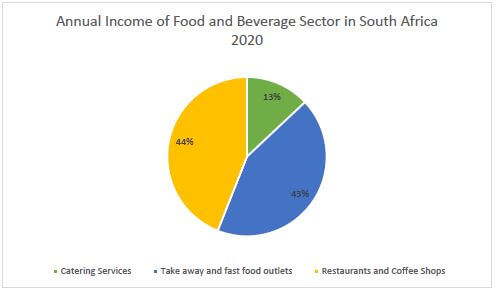
1.3.2.
- Decrease in catering services = 8473.50 – 4426.40
= 4047.10 R million
Decrease in Take away and fast foods outlets = 18411.10 – 14477.90
= 3933.20 R million
Decrease in Restaurants and Coffee Shops = 29742 – 14802.30
= 14939.70
Restaurants and Coffee Shops showed the largest decline - This is because of covid-19 pandemic which saw restaurants closed down by the government to minimize human interactions and reduce chances of them contracting the virus.
HOSPITALITY STUDIES GRADE 12 MEMORANDUM - AMENDED SENIOR CERTIFICATE EXAMS PAST PAPERS AND MEMOS MAY/JUNE 2018
HOSPITALITY STUDIES
GRADE 12
AMENDED SENIOR CERTIFICATE EXAMS
PAST PAPERS AND MEMOS
MAY/JUNE 2018
MEMORANDUM
SECTION A
QUESTION 1
1.1 MULTIPLE-CHOICE QUESTIONS
1.1.1 | C√ |
1.1.2 | C√ |
1.1.3 | D√ |
1.1.4 | C√ |
1.1.5 | A√ |
1.1.6 | C√ |
1.1.7 | B√ |
1.1.8 | A√ |
1.1.9 | C√ |
1.1.10 | A√ |
(10)
1.2 MATCHING ITEMS
1.2.1 | D√ |
1.2.2 | E√ |
1.2.3 | A√ |
1.2.4 | G√ |
1.2.5 | F√ |
1.2.6 | C√ |
(6)
1.3 ONE-WORD ITEMS
1.3.1 | Bellboy / Concierge√ | M6 |
1.3.2 | Crudités√ | M68 F16 |
1.3.3 | Bicarbonate of soda√ | M103 |
1.3.4 | Marbling√ | F192 M81 |
1.3.5 | Vacherin√ | F151 M141 |
1.3.6 | Laundry√ | M3 |
1.3.7 | Sparkling / Champagne √ | F48 M156 |
1.3.8 | Sec√ | F 48 M156 |
1.3.9 | Aperitif√ | F51 M165 |
1.3.10 | Frosting√ | F65 M161 |
(10)
1.4 SELECTION
1.4.1 | B √ C√ F√ G√ Any order |
1.4.2 | B√ D√ F√ H√ Any order |
(8)
1.5. MATCHING ITEMS
1.5.1 | C√ (ii) √ |
1.5.2 | A √ (iv) √ |
1.5.3 | B√ (i) √ |
(6)
TOTAL SECTION A: 40
SECTION B: KITCHEN AND RESTAURANT OPERATIONS. HYGIENE, SAFETY AND SECURITY
QUESTION 2
2.1
2.1.1 Hepatitis A√ (1)
- Caused by the hepatitis virus√
- Contagious liver disease√
- Makes liver to swell and stops it from working effectively√ (Any 2) (3)
2.1.2
- Tiredness√
- Upset stomach√
- Fever√
- Loss of appetite√
- Stomach pain√
- Diarrhoea√
- Dark yellow urine√
- Light coloured stools√
- Yellowish skin or eyes√
- Nausea√ (Any 3) (3)
2.1.3 Agree√
- Both hepatitis and gastro-enteritis requires you to wash hands after using the toilet √
- Both require the washing hands before preparing food or eating√
- Drinking treated water√
- Both sufferers only return to work when they are free from the symptoms√ (Any 3) (3)
2.2
2.2.1
- Description of the goods√
- The price/value per unit√
- Quantity that was received√
- Quantity that was issued√
- New balance of the stock/stock on hand√
- Cash column√
- Date√
- Signature √
- Requisition/order/bin number √ (Any 3) (3 )
2.2.2
- Less time consuming√
- Easy to determine the quantity of stock that should be in the store at any given time√
- Stock figures can be compared, differences can be highlighted√
- The total cost of the stock will be recorded instantly and will be deducted from the stock list√ (Any 3) (3)
2.3
2.3.1
- Customers will get a negative image therefore they will not return to the restaurant√
- The restaurant will make less money√
- The customers will not speak favourably about their experience at the restaurant√
- Customers will not be satisfied √ (Any 2) (2)
2.3.2
- Yes/No√
- The uniform of the waiter is clean√
- Waiter is clean shaven√
- Hair is out of the waiters face√
- Foot wear is clean and safe√
- Waiter is not wearing excessive jewellery√
- Waiter is smoking in front of the restaurant √
- Sleeves are rolled up√ (Any 3) (3)
TOTAL SECTION B: 20
SECTION C: NUTRITION AND MENU PLANNING; FOOD COMMODITIES
QUESTION 3
3.1
3.1.1
TWO UnsuitableIngredients | Replacements | |
Jews | Bacon√ | Macon, chicken bacon. √ |
Parmesan cheese√ | Breadcrumbs, chopped herbs√ | |
Minced beef√ (Any 2) | Chicken, tuna, soya mince √ (Any 2) | |
Hindus | Minced beef√ / Bacon√ | Soya mince√ |
Red wine √ | Vegetable stock√ (2) | |
(Any ) |
(8)
3.1.2
- Chuck√
- Thin flank√
- Topside√
- Neck√
- Bolo√
- Thick flank√ (Any 2) (2)
3.2
3.2.1
- Temperature should be between 1-2 ºC√
- Store in a loosely wrapped plastic√
- Remove all air from the packaging√
- Can be vacuum packed which will last for 2 weeks √ (Any 3) (3)
3.2.2
- slow freezing produces large ice crystals that tend to break the muscle tissue√
- The nutritional value, appearance and taste of meat is not affected√
- Sarcoplasm is retained√ (Any 2) (2)
3.2.3 Thawed in its packaging or covered√ slowly in the refrigerator overnight√ (2)
3.3
3.3.1
- Colour: Brown√ / Pink√ (Any 1) (1)
- Class: B /BBB√ / C√ (Any 1) (1)
3.3.2 Less tender / tough√ because:
- it is an older animal √
- meat with yellow fat is tough√ (Any 2) (2)
3.4
3.4.1
- Depends on the budget√ and the personal taste of the clients√
- Should have at least 6-8 different types of snacks√
- Make sure that you include items that can be served hot or cold, baked or fried√
- Keep flavour, colour and temperature in mind√
- Keep seasonal food in mind√
- Allow three to four cold snacks and three to four hot snacks per person√ (Any 4) (4)
3.4.2
- Cocktail functions can take place in the late afternoon, evening or late evening√
- 17:00-19:00√ (Any 1) (1)
3.4.3
- Decorate the venue according to the theme√
- A central table for display of food is required√
- Smaller tables can be provided for used side plates and glasses√
- There must be sufficient side plates, glasses and serviettes for the number of guests invited√
- If using chairs, scatter them around the venue√
- Set up audio-visual equipment for speeches and check its working condition√
- Place cutlery and holders on the buffet tables√
- Set up the table for the drinks√ (Any 4) (4)
3.5
3.5.1
- Charlotte Muscovite√
- Ice cream√ (2)
3.5.2
- Beat egg yolk and sugar√
- Cook egg yolks mixture, milk, and vanilla in a bain marie√/ double boiler/ over hot water √
- Stir continuously√
- Stir until it coats the back of a spoon√
- Great care should be taken to prevent curdling during the preparation√ (Any 3) (3)
3.5.3 Baked Alaska√ (1)
3.5.4 1 part egg whites to 1 part sugar√ (1)
3.5.5
- Egg whites must be free from any traces of egg yolks√
- Equipment should be free from traces of fat√
- Egg whites must be at room temperature√
- Use cream of tartar or lemon juice to stabilise foam√
- use glass, porcelain, copper or stainless steel bowls √ (Any 3) (3) [40]
QUESTION 4
4.1
4.1.1 Short crust pastry√ (1)
4.1.2 Docking√
- Piercing small holes into the raw pastry to allow any trapped air to escape√ and to prevent the pastry from rising during the baking process√ (2)
4.1.3
- To prevent the pastry from becoming soggy√
- Keeps the juices in√ (Any 1) (1)
4.1.4
- Protein√
- Vitamin B√
- Iron√
- Potassium√
- Carbohydrates√
- Fibre√ (Any 2) (2)
4.1.5 To remove :
- Dirt such as stones and pebbles√
- Impurities√
- Bad and broken lentils√ (Any 1) (1)
4.1.6
- Salt slows down the cooking process√
- Causes the lentils to harden√ (Any 1) (1)
4.1.7
- Pesco√
- Lacto-ovo√
- Pollo√
- Pollopescatarean / Semi vegetarian √
- Flexitarian √ (Any 3) (3)
4.2
4.2.1
- To develop steam√
- To form a cavity which expands inside the batter√ (2)
4.2.2
- To dry out the pastry completely√
- Forms a crispy shell√
- Prevents burning√ (Any 2) (2)
4.2.3
- To allow trapped steam to escape √
- The trapped steam can cause softening of the puffs√ (Any 1) (1)
4.3
4.3.1 Bottling / Pickling√ (1)
4.3.2
- Vinegar√
- Salt√
- Sugar√ (Any 2) (2)
4.3.3
- Cucumber√
- Cauliflower√
- Green bean√
- Chillies√
- Peppers√
- Asparagus√
- Peas√
- Corn√ (Any relevant ) (2)
4.3.4
- o prevent the beetroot from having a metallic taste√ due to the reaction with the acid√
- Acid discolours pot√ (2)
4.4
4.4.1
- Food cost = Filling + Crust √
= R500-00 + R300-00√
= R800-00√
=R800-00/50 people√
=R16-00 per person√ (Any 3) (3) - Total cost of the dish = Food cost + Labour cost + Overhead cost√
= R800-00 + R100-00 + R180-00√
=R1080-00√ (3)
4.4.2
- Electricity√
- Water√
- Serving platters√ (3)
4.5
4.5.1
- Step 1 (b): Hydrate the gelatine powder in 30 ml water. √
- Step 2 (d): Bring fig juice and sugar to a boil √
- Step 3 (a): Disperse the gelatine in the hot juice mixture. √
- Step 4 (c): Mix figs and 230g cream cheese into the gelatine mixture. √
- Step 5 (f): Pour into wet mould. √
- Step 6 (e): Refrigerate and leave to set. √ (6)
4.5.2
- The fresh figs contain a proteolytic enzyme which break down the protein in the gelatine√
- Enzyme in fresh figs prevents gel formation√
- Figs have the enzyme ficin√ (Any 2) (2) [40]
TOTAL SECTION C: 80
SECTION D: FOOD AND BEVERAGE SERVICE
QUESTION 5
5.1
5.1.1
- School teachers√
- Members of the community who visit farm stall or flea market√
- Tourists visiting farm stall or the flea market√ (Any 2) (2)
5.1.2 Strengths:
- Hospitality Studies learner√
- Lives 5 kilometres outside the town√
- Busy tourist route√
- Two locals help in the selling of fruit√
- Helped by her experienced grandmother√
- She uses recycled bottles√
- Mpho sells to school teachers√
- Sells at the farm stall and flea market√ (Any 4) (4)
5.1.3 Threats:
- Competition (someone making the same preserves) √
- Rising fuel prices (transportation of goods) √
- Fruit spoiling√
- Time management ( unforeseen school activities) √
- Weather / drought (trees not bearing fruits) √
(Any relevant) (3)
5.1.4.
- Poster has a description of the product√
- It is neat and attractive√
- The lettering is big√
- Name of the product is visible√
- Poster is free from spelling mistakes√
- Promotion is there (free tasting on homemade bread)√
BUT:
- There is no price√, slogan√, address or contact details√, picture of the product√, (Any 5) (5)
5.1.5
- Product√ : Apricot Jam√
- Place√: Ubuntu farm stall√
- People√: School teachers, Members of the community who visit farm stall or flea market, tourists visiting farm stall or the flea market√
- Promotion: free tasting on homemade bread, poster√ (Any 3×2) (6)
5.1.6
- the glass bottles are easy to handle√
- suitable for preserving jams√
- recycled bottles are suitable for jam if hygienically cleaned√ √
- bottles need to be suitable for the jam(bottles need to be sterilised before the jam is added)√
- She can put branding/labels on the bottles√
- Attractive labels and branding can be added√
- Information can be added√
(Any 4) (4)
5.1.7
- Creates job opportunities√
- Stimulates economic growth√
- Improves infrastructure√
- Contributes to development and improvement of the locals√
- Tourists bring valuable foreign currency√
- Esteem and living standards of the community improves√ (Any 3) (3)
5.2
- Front office is the heart of the accommodation establishment√
- Guests makes use of front office when making a booking, check in, check out and settling of account√
- Enquiries are handled in this office√
- Contributes to the economy by selling goods and services that generate income and create jobs√
(Any 3) (3) [30]
QUESTION 6
6.1
6.1.1
- Glass A: Cocktail / Martini√
- Glass B: Red / White / Wine√ (2)
6.1.2 Presenting wine. √ (1)
6.1.3
- Stand on the right-hand side of the guest. √
- Hold the wine selected on a service cloth in your hand with the label facing towards the host. √
- Present the wine to the host while saying the name and vintage of the wine to confirm that it is the correct one. √
- Allow the host to feel the temperature of the wine should he / she wish to. √
- Open the bottle once the host is satisfied. √ (Any 4) (4)
6.1.4
- Name of the wine √ – Riesling. √
- Producer / Estate√ – Barnard vineyards. √
- Vintage / Harvest year √ – 2011√ (3 × 2) (6)
6.1.5
- Not suitable, √ because Riesling is a white wine√ and beef stew is a red meat that pairs well with a red wine. √
6.2
6.2.1 Mervin should:
- Clean and care for bar equipment √
- Clean glasses, jugs and cocktail equipment before packing them out/steam glasses √
- Arrange bar condiments and accessories i.e. peanut bowls, bill dockets, straws. √
- Arrange glasses in the storeroom√
- Empty rubbish bins√
- Wipe bar counters √
- Wash the bar floor√
- Clean the sink in the bar√ (Any 3)
6.2.2
- When clearing the bar Mervin should first conduct a stock take of consumables. √
- He should clear the bar top and pack away all equipment. √
- He should wash and polish used glasses. √
- Mervin should remove all empty bottles. √
- He should empty the liqueur trolley and return stock to the bar cupboard. √
- He must restock the bar from the cellar. √ (Any 4)
6.2.3 Mervin should:
- Not serve him/her any more alcoholic beverages. √
- Keep calm. √
- Be friendly but firm at all times and avoid showing emotions. √
- Ask the customer politely but firmly to leave rather than allowing him/her to disturb other guests. √
- inform the staff that can remove him/her if necessary. √
- Keep the incident as quiet as possible. √ (Any 4)
6.2.4 Mervin will:
- mix the ingredients in a glass in which it will be served. √
- float the ingredients on top of each other and form layers in the glass. √
- place swizzle sticks in the glass to allow the ingredients to mix. √
[30]
TOTAL SECTION D: 60
GRAND TOTAL: 200
HOSPITALITY STUDIES GRADE 12 QUESTIONS - AMENDED SENIOR CERTIFICATE EXAMS PAST PAPERS AND MEMOS MAY/JUNE 2018
HOSPITALITY STUDIES
GRADE 12
AMENDED SENIOR CERTIFICATE EXAMS
PAST PAPERS AND MEMOS
MAY/JUNE 2018
INSTRUCTIONS AND INFORMATION
- This question paper consists of FOUR sections.
SECTION A: Short questions (all topics) (40)
SECTION B: Kitchen and restaurant operations;
Hygiene, safety and security (20)
SECTION C: Nutrition and menu planning;
Food commodities (80)
SECTION D: Sectors and careers;
Food and beverage service (60) - Answer ALL the questions in the ANSWER BOOK.
- Number the answers correctly according to the numbering system used in this question paper.
- Write neatly and legibly.
QUESTIONS
SECTION A: SHORT QUESTIONS
QUESTION 1
1.1 MULTIPLE-CHOICE QUESTIONS
Various options are provided as possible answers to the following questions. Choose the answer and write only the letter (A–D) next to the question numbers (1.1.1 to 1.1.10) in the ANSWER BOOK, e.g. 1.1.11 D.
EXAMPLE:
1.1.11 A grape variety used to make wine:
- Cultivar
- Vintage
- Product
- Origin
ANSWER:
1.1.11 A
1.1.1 A liquor licence is valid for …
- 1 month.
- 6 months.
- 1 year.
- 10 years. (1)
1.1.2 When serving sparkling wine, …
- pour it from the left-hand side.
- fill the glass half full.
- tilt the bottle at an angle of 45 °C.
- serve it at room temperature. (1)
1.1.3 Plates are ready to be cleared when the …
- guests have stopped eating.
- fork and spoon are placed near each another.
- guests have left the table.
- fork and knife are placed together on the plate. (1)
1.1.4 During the crumbing down process …
- only empty glasses are removed.
- the dessert utensils are removed.
- the dessert utensils are pulled down.
- all items, except the cruet set, are removed. (1)
1.1.5 A product can be defined as something ...
- tangible that can be exchanged for money.
- intangible that can be provided as a service.
- tangible that cannot be exchanged for money.
- tangible that cannot be provided as a service. (1)
1.1.6 The following food will NOT be consumed by followers of Islam:
- Beef roll
- Sour milk
- Bacon bits
- Shell fish (1)
1.1.7 Sugar and vinegar are used to preserve …
- chakalaka.
- chutney.
- marmalade.
- sauerkraut. (1)
1.1.8 When a piece of meat is covered with thin slices of fat it is known as …
- barding.
- larding.
- marinating.
- binding. (1)
1.1.9 The most important raising agent in profiteroles is …
- baking powder.
- yeast.
- steam.
- bicarbonate of soda. (1)
1.1.10 The function of the flour in choux pastry is to …
- ensure a fine texture.
- emulsify fat.
- gelatinise starch.
- ensure a stiff dough. (1)
1.2 MATCHING ITEMS
Choose the most suitable accompaniment from COLUMN B that matches the type of meat in COLUMN A. Write only the letter (A–H) next to the question numbers (1.2.1 to 1.2.6) in the ANSWER BOOK, e.g. 1.2.7 J.
COLUMN A | COLUMN B |
1.2.1 Châteaubriand 1.2.2 Mogodu 1.2.3 Roast pork 1.2.4 Roast beef 1.2.5 Roast mutton 1.2.6 Mutton curry |
|
(6 x 1) (6)
1.3 ONE-WORD ITEMS
Give ONE term/word for EACH of the following descriptions. Write only the term/word next to the question numbers (1.3.1 to 1.3.10) in the ANSWER BOOK.
1.3.1 A hotel staff member responsible for welcoming the guests at their vehicles, opening their car doors and organising luggage
1.3.2 Platters of vegetables that are cut into smaller portions and served with a dip
1.3.3 An ingredient added to dry beans that will prevent flatulence
1.3.4 Intra-muscular fat that is spread throughout the muscle of meat
1.3.5 A crisp, hard meringue shell used as a base for fruit and ice cream
1.3.6 An area in a hotel that is both revenue and non-revenue generating
1.3.7 The most suitable wine to be served with caviar and oysters
1.3.8 The term that is used to describe dry sparkling wine
1.3.9 A type of alcoholic drink served before dinner
1.3.10 Garnishing the rim of a glass with sugar or salt (10)
1.4 SELECTION
1.4.1 Identify FOUR food products in the list below that are preserved using fermentation. Write only the letters (A–H) next to the question number (1.4.1) in the ANSWER BOOK.
- Ham
- Buttermilk
- Olives
- Corned beef
- Chutney
- Beer
- Cheese
- Marmalade (4)
1.4.2 Select FOUR cocktail snacks in the list below that are prepared from puff pastry. Write only the letters (A–H) next to the question number (1.4.2) in the ANSWER BOOK.
- Barquettes
- Palmiers
- Hertzoggies
- Bouchées
- Samoosas
- Vol-au-vents
- Baklava
- Mille-feuilles (4)
1.5 MATCHING ITEMS
Match a disease in COLUMN B with the description in COLUMN A and a symptom in COLUMN C. Write only the letter (A–D) from COLUMN B and the Roman numerals ((i)–(vi)) from COLUMN C next to the question numbers (1.5.1 to 1.5.3) in the ANSWER BOOK, e.g. 1.5.6 H (viii).
COLUMN A DESCRIPTION | COLUMN B DISEASE | COLUMN C SYMPTOM |
1.5.1 Acute bacterial infection of the small intestine |
|
|
(3 x 2) (6)
TOTAL SECTION A: 40
SECTION B: KITCHEN AND RESTAURANT OPERATIONS; HYGIENE, SAFETY AND SECURITY
QUESTION 2
2.1 Study the article below and answer the questions that follow.
18 June 2011 Pretoria: The Department of Health urged all residents to employ good personal hygiene, like washing hands with soap and water after using the toilet and before eating. This highly infectious disease causes the liver to swell. It is reported to be more prevalent in areas where hygiene and sanitary conditions are poor. [Adapted from SANEWS.gov.za] |
2.1.1 Name and describe the disease mentioned in the article. (3)
2.1.2 Describe THREE symptoms that affected residents could have experienced. (3)
2.1.3 The disease named in QUESTION 2.1.1 and gastro-enteritis have similar preventative measures. Do you agree with this statement or not? Motivate your answer. (3)
2.2
2.2.1 List the information that needs to be included on a computerised stock sheet. (3)
2.2.2 Explain how the information listed in QUESTION 2.2.1 will benefit an establishment. (2)
2.3 Study the picture below and answer the questions that follow: 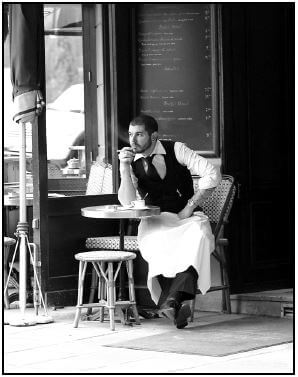
2.3.1 First impressions are very important in the hospitality industry. Explain what impression the image above will create and also what the impact thereof will be on the restaurant. (2)
2.3.2 Do you consider the professional appearance of the waiter appropriate or not? Motivate your answer. (4)
TOTAL SECTION B: 20
SECTION C: NUTRITION AND MENU PLANNING; FOOD COMMODITIES
QUESTION 3
3.1 Study the ingredients for spaghetti bolognaise below and answer the questions that follow. 
3.1.1 Select TWO ingredients that make the spaghetti bolognaise unsuitable for strict Jews and Hindus. Recommend a replacement ingredient for each. Tabulate your answer as follows: (8)
TWO UNSUITABLE INGREDIENTS | TWO REPLACEMENT INGREDIENTS | |
Jews | (2) | (2) |
Hindus | (2) | (2) |
3.1.2 Recommend TWO suitable meat cuts that can be used to make the minced beef. (2)
3.2 Minced beef can be refrigerated or frozen for use later on.
3.2.1 Discuss how minced beef should be stored in the refrigerator. (3)
3.2.2 Motivate why minced beef should be frozen as quickly as possible when it goes into the freezer. (2)
3.2.3 Explain the best method to thaw the above minced beef. (2) 3.3 Study the advertisement below and answer the questions that follow.
Yellow-fat rump steak and biltong for SALE! |
3.3.1 Identify the following with regard to the roller mark that will be found on the rump steak above:
- Colour (1)
- Symbol (Class) (1)
3.3.2 Comment on the tenderness of the meat cuts with yellow fat. Motivate your answer. (2)
3.4 You have to plan a cocktail function for 60 guests who will be celebrating Women's Day.
3.4.1 State THREE principles you would adhere to when planning your cocktail menu. (4)
3.4.2 Write down the ideal time for the function. (1)
3.4.3 Explain how the venue should be prepared for the above function. (4)
3.5 Study the pictures below and answer the questions that follow. 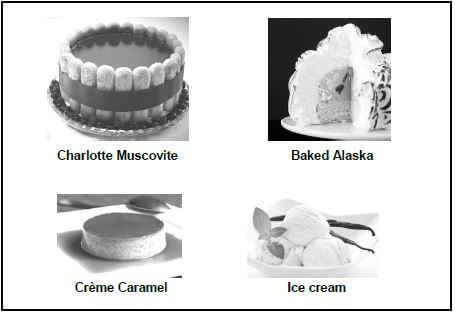
3.5.1 Identify TWO of the above desserts that have a crème anglaise base. (2)
3.5.2 Explain how a crème anglaise is prepared. (3)
3.5.3 Identify ONE dessert that can be flambéed during service. (1)
3.5.4 A successful meringue will depend on the correct ratio of sugar and eggs whites. Write down the correct ratio for the Baked Alaska's meringue. (1)
3.5.5 Give THREE guidelines that have to be considered to ensure that the meringue is a success. (3) [40]
QUESTION 4
4.1 Study the pictures below and answer the questions that follow. 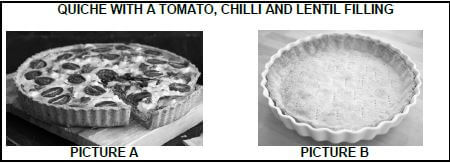
4.1.1 Identify the type of pastry used in PICTURE A. (1)
4.1.2 Name and explain the technique applied in PICTURE B. (2)
4.1.3 Motivate why the pastry shell above should be sealed with an egg wash before adding the filling. (1)
4.1.4 Name TWO nutrients found in lentils. (2)
4.1.5 Explain why the lentils should be sorted before cooking. (1)
4.1.6 Give a reason why salt is only added at the end when cooking lentils. (1)
4.1.7 Suggest THREE types of vegetarians who will consume the quiche in PICTURE A. (3)
4.2 Study the picture below and answer the questions that follow. 
Give reasons for the following actions when baking the pastry above:
4.2.1 Bake at 200 °C for a short while. (2)
4.2.2 Reduce the temperature to 180 °C. (2)
4.2.3 Pierce the éclair with a testing pin at the end of the baking process. (1)
4.3 Study the picture below and answer the questions that follow. 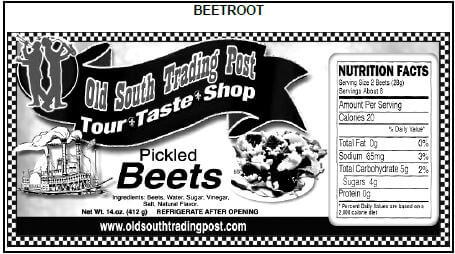
4.3.1 Identify the method of preservation used for the product in the label above. (1)
4.3.2 Name TWO natural preservatives that appear on the label above. (2)
4.3.3 Suggest TWO other vegetables where the same preservation method can be used. (2)
4.3.4 Comment on why aluminium pots should not be used to prepare the beetroot above. (2)
4.4 Study the information below and answer the questions that follow.
QUICHE COSTING FOR 50 GUESTS | |
Filling | R500,00 |
Crust | R300,00 |
Electricity | R50,00 |
Water | R30,00 |
Labour | 2 hours @ R50,00 per hour |
Serving platters | R2,00 each |
4.4.1 Calculate the following. SHOW ALL CALCULATIONS.
- Food cost per person (3)
- Total cost of the quiche (3)
4.4.2 Identify THREE overhead costs in the information above. (3)
4.5 Study the recipe below and answer the questions that follow. 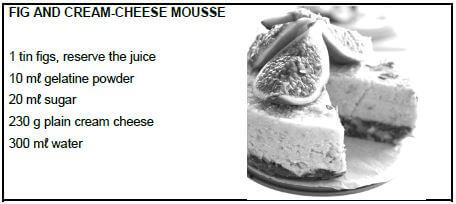
4.5.1 Rearrange the following steps to prepare the fig mousse above in the CORRECT order. Write down only the letters (a) to (f).
- Disperse the gelatine in the hot fig-juice mixture.
- Hydrate the gelatine powder in 30 mℓ water.
- Mix figs and 230 g cream cheese into gelatine mixture.
- Bring fig juice and sugar to boil.
- Refrigerate and leave to set.
- Pour into a wet mould. (6)
4.5.2 Study the table below and answer the question that follows.
CLASS GROUP A | CLASS GROUP B |
Group A used the same recipe above. | Group B used the same recipe but instead of canned figs used fresh figs. |
The end product of Group B was that the mousse did not set. Explain why. (2) [40]
TOTAL SECTION C: 80
SECTION D: SECTORS AND CAREERS; FOOD AND BEVERAGE SERVICE
QUESTION 5
5.1 Study the extract below and answer the questions that follow.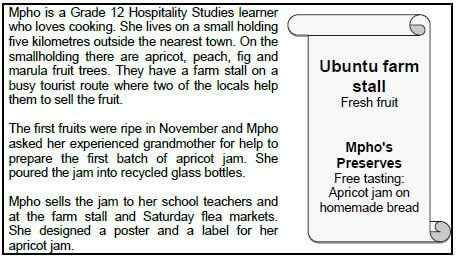
5.1.1 Identify Mpho's target market. (2)
5.1.2 Select FOUR strengths of Mpho's business from the extract. (4)
5.1.3 Predict THREE possible threats that Mpho could encounter in her business venture. (3)
5.1.4 Evaluate the poster above. (5)
5.1.5 Identify THREE P's with examples in the above extract, other than packaging. (6)
5.1.6 Discuss the suitability of the recycled glass bottles for Mpho's jam. (4)
5.1.7 Explain how Mpho's business will contribute to the South African economy. (3)
5.2 Discuss the importance of the front-office department in an accommodation establishment. (3) [30]
QUESTION 6
6.1 Study the photographs below and answer the questions that follow. 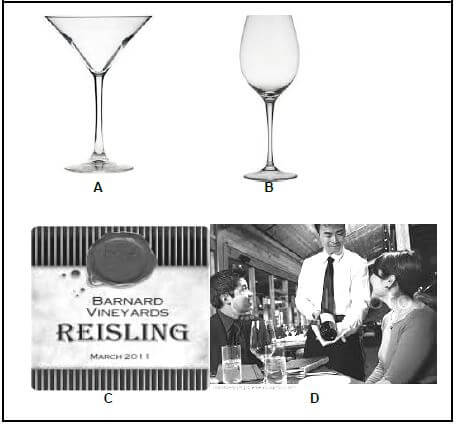
6.1.1 Suggest the beverages that would be served in glasses A and B respectively. (2)
6.1.2 Indicate the procedure performed in picture D. (1)
6.1.3 Explain how the procedure in QUESTION 6.1.2 is performed. (4)
6.1.4 Identify and describe the information that appears on the wine label in picture C. (3 × 2) (6)
6.1.5 Evaluate the suitability of the wine if it is served with beef stew. Motivate your answer. (3)
6.2 Mervin has been appointed as the head barman in the local hotel.
6.2.1 Explain how Mervin would perform the opening mise-en-place at the bar. (3)
6.2.2 Outline the procedure Mervin should follow when clearing the bar. (4)
6.2.3 Describe how an intoxicated (drunk) customer should be handled by the bar waiter. (4)
6.2.4 Explain how Mervin will prepare a built cocktail. (3) [30]
TOTAL SECTION D: 60
GRAND TOTAL: 200
INFORMATION TECHNOLOGY PAPER 2 GRADE 12 QUESTIONS - AMENDED SENIOR CERTIFICATE EXAMS PAST PAPERS AND MEMOS MAY/JUNE 2018
INFORMATION TECHNOLOGY
PAPER 2
GRADE 12
AMENDED SENIOR CERTIFICATE EXAMS
PAST PAPERS AND MEMOS
MAY/JUNE 2018
INSTRUCTIONS AND INFORMATION
- This question paper consists of SIX sections:
SECTION A: Short Questions (16)
SECTION B: Systems Technologies (24)
SECTION C: Communication and Network Technologies (22)
SECTION D: Data and Information Management (23)
SECTION E: Solution Development (25)
SECTION F: Integrated Scenario (40) - Answer ALL the questions.
- Read ALL the questions carefully.
- The mark allocation generally gives an indication of the number of facts/reasons required.
- Number the answers correctly according to the numbering system used in this question paper.
- Write neatly and legibly.
QUESTIONS
SECTION A: SHORT QUESTIONS
QUESTION 1
Various options are provided as possible answers to the following questions. Choose the answer and write only the letter (A to D) next to the question numbers (1.1.1 to 1.1.3 and 1.2.1 to 1.2.2) in the ANSWER BOOK, e.g. 1.1.4 D.
1.1 1.1.1 The most common protocol used to send e-mail is known as …
- POP3
- FTP
- SMTP
- VoIP (1)
1.1.2 Which ONE of the following refers to an encryption process used to authenticate the identity of the sender of an e-mail message?
- Digital certificate
- Digital fingerprint
- Digital handshake
- Digital signature (1)
1.1.3 Which ONE of the following refers to a data structure that is non-volatile?
- String
- One-dimensional array
- Two-dimensional array
- Text file (1)
1.2
1.2.1 The following declaration statements are provided:
var
K : integer;
R : real;
The assignment statements below have been coded:
- K := 25 div 4;
- K := R + 2;
- K := R div 5;
- R := 15 mod 4;
Which of the above assignment statements will cause a compilation/ syntax error?
- (i) and (iii)
- (i) and (iv)
- (ii) and (iii)
- (ii) and (iv) (2)
1.2.2 Determine the value of sAnswer after the execution of the statements below.
sLine := 'Information Technology is great';
sAnswer := copy(sLine, pos('n',sLine)-1, 4);
Insert('T',sAnswer, 2);
- nfo T
- ITnfo
- nfoT
- nTfo (2)
1.3 Give ONE word/term for each of the following descriptions. Write only the word/term next to the question numbers (1.2.1 to 1.2.10) in the ANSWER BOOK.
1.3.1 Web applications designed to deliver the functions and features of a traditional desktop application online. The interface is generated locally by your web browser. (1)
1.3.2 An type of information system that gathers, analyses and presents information for the management, operations and planning levels of an organisation. This helps to make decisions about problems that may be rapidly changing. (1)
1.3.3 Downloaded software that bombards the user with advertisements (1)
1.3.4 A remotely controlled network of zombie computers (1)
1.3.5 A type of memory that stores the BIOS settings (1)
1.3.6 Testing the accuracy of captured data by checking it against the source of the data (1)
1.3.7 Someone who gains unauthorised access to data in order to steal data or someone who makes unauthorised changes to data (1)
1.3.8 Specialised hardware and software designed to be used at till points (1)
1.3.9 E-mail sent to people that advertise products that were not requested (1)
TOTAL SECTION A: 16
SECTION B: SYSTEMS TECHNOLOGIES
QUESTION 2
2.1 Computers have modular designed motherboards.
2.1.1 Give ONE advantage of a modular designed motherboard. (1)
2.1.2 Name ONE component/device that could be plugged into any of the ports in the rear of a standard desktop computer. (1)
2.1.3 What is the purpose of RAM? (1)
2.1.4 Explain what CPU cache memory is and how it impacts the processing speed of a computer. (3)
2.1.5 Explain the concept of multiprocessing. (2)
2.2 The younger generation of computer users often prefer to use mobile devices rather than desktop computers.
2.2.1 Except for mobility, give TWO other reasons why mobile devices may be preferred to desktop computers. (2)
2.2.2 State TWO factors that limit the use of mobile devices. (2)
2.2.3 Give TWO reasons for using an SSD instead of a conventional hard drive in a mobile device. (2)
2.3 The use of cloud applications, such as Google Docs, as well as other types of Software as a Service (SaaS) is popular practice nowadays.
2.3.1 What is a cloud application? (1)
2.3.2 Give TWO reasons for using SaaS instead of standard desktop software. (2)
2.3.3 State ONE disadvantage associated with the use of cloud computing. (1)
2.3.4 Cloud computing relies on virtualisation technologies. State TWO ways in which virtualisation techniques are used by companies that offer cloud services. (2)
2.4 The library at a school uses an online digital media repository.
2.4.1 What is an online digital media repository? (1)
2.4.2 Give TWO reasons for using a media repository. (2)
2.5 The library at the school wants to implement a backup policy to backup their data. Give ONE reason why an online backup service is recommended. (1)
TOTAL SECTION B: 24
SECTION C: COMMUNICATION AND NETWORK TECHNOLOGIES
QUESTION 3
The diagram below illustrates the network of a small business. 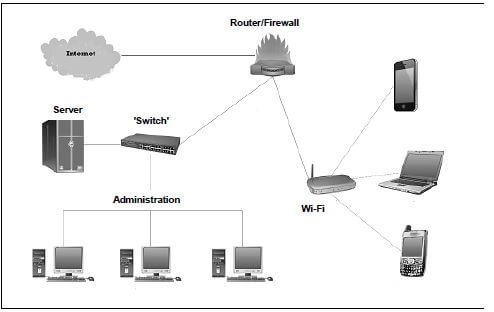
3.1 The computers in the cabled network are used by all staff members and the WLAN is used by clients.
3.1.1 Give ONE reason why a wireless network is more suitable for the clients. (1)
3.1.2 Give ONE reason why all devices must have a unique IP address. (1)
3.1.3 Give TWO possible reasons why clients using the WLAN could experience slow connection speeds sometimes. (2)
3.2 The LAN in the administration office uses a client-server model and provides internet access.
3.2.1 Name TWO services that can be provided by an ISP besides the connection to the internet. (2)
3.2.2 State TWO benefits of using an ADSL connection. (2)
3.2.3 Explain the function of the switch as part of the LAN. (2)
3.2.4 The LAN to be used by the administration staff uses fibre-optic cables.
- What medium is used by fibre-optic cables to transmit signals? (1)
- Give TWO reasons why fibre-optic cables will be more suitable for use in a LAN than UTP cables. (2)
3.3 It is a requirement that all computers in the LAN are thin clients and that a UPS be installed for the server.
3.3.1 Explain what a thin client is. (1)
3.3.2 Give TWO reasons why the use of thin clients is often preferred. (2)
3.3.3 What is the purpose of a UPS? (1)
3.4 Some staff members have access to the virtual private network (VPN) of the business.
3.4.1 Give ONE practical example of how the staff can benefit from using the VPN. (1)
3.4.2 Name the technique that is used to maintain the privacy of information during transmission on a VPN. (1)
3.4.3 Give TWO possible reasons why a staff member may encounter problems trying to connect to the VPN. (2)
3.5 The size of an e-service can range from very small to very large. What is the term used to describe the capability of a system to handle a reduction or a growth of its workload, or its potential to be reduced or enlarged to accommodate a possible reduction or growth of its workload? (1)
TOTAL SECTION C: 22
SECTION D: DATA AND INFORMATION MANAGEMENT
QUESTION 4
4.1 A library uses a relational database to have a record of books that have been borrowed.
4.1.1 Explain what a relational database is. (2)
4.1.2 Explain why record locking is necessary when different staff members are working on the same table in the database. (2)
4.1.3 Besides planning and creating a database, name TWO other tasks that a database administrator has to perform as part of his/her duties. (2)
4.2 The database of the library has two tables: tblStudents and tblBooksBorrowed. The table tblStudents keeps record of the students who use the services of the library. The table tblBooksBorrowed keeps record of the books borrowed by a student.
The relationship between the tables is given below. 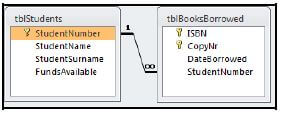
4.2.1 The student number in the tblStudents table is the primary key. Explain what a primary key is in this context. (1)
4.2.2 What is the StudentNumber field in the tblBooksBorrowed table called in terms of the relationship between the tables? (1)
4.2.3 A composite primary key is used in the tblBooksBorrowed table. What is meant by a composite primary key? (1)
4.2.4 Identify and motivate the specific relationship that exists between the tblStudents and the tblBooksBorrowed tables. (2)
4.2.5 Referential integrity was enforced when the relationship between the tables was created. Why was this done? (2)
4.2.6 The extract of data below shows some of the records in the two tables. 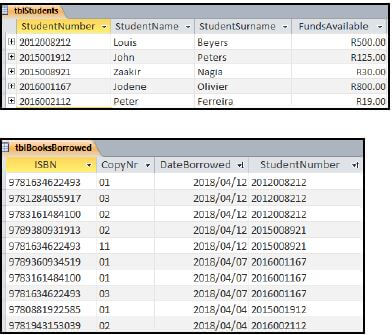
- Write an SQL statement to display the name, surname and funds available of all the students with R30 or less in their account. (3)
- Write an SQL statement to display the student number and number of books borrowed of all the students who have more than two books on loan. The number of books borrowed must be shown in a field called NumberBorrowed. (7)
TOTAL SECTION D: 23
SECTION E: SOLUTION DEVELOPMENT
QUESTION 5
5.1 Give a reason for the use of EACH of the following structures in a Delphi program:
5.1.1 FormCreate event (1)
5.1.2 A WHILE loop instead of a FOR loop (1)
5.1.3 Ord function (1)
5.2 Students can log in on the university's website or portal to access resources.
5.2.1 Below is an incomplete class diagram for an object class that was created to record access to a website.
StudentEntry |
Attributes |
-fStudentCode(String) |
-fStudentName(String) |
-fDateOfEntry |
-fTimeOfEntry |
-fLoginNumber(integer) |
Methods |
+Constructor Create |
+toString:String |
- An object's attributes should be encapsulated. Define the term encapsulation. (2)
- Suggest a suitable data type for the fDateOfEntry attribute. (1)
- Define a method that can be added to the class diagram to return the student code of the object. (1)
- Define a method that can be added to the class diagram that receives a parameter and changes the login number. (1)
- What type of method is the toString method? (1)
5.2.2 The student numbers of at least 1 000 IT students are stored in an array called arrStudNumbers. The final results for the Mathematics module are stored in a parallel array called arrMathResults.
Example of the first five student numbers and results in the respective arrays: 
The following code was used to enter a student number and update the student's result: 
- Name the type of search technique used in the code above. (1)
- Criticise the program code provided in terms of good and effective programming techniques. (1)
- Write pseudo code that uses a more effective search technique that will terminate the search process when the update has been done. (8)
5.3 The following segment of programming code was used to generate a student code: 
Copy and complete the trace table below to determine the output of this program segment if the name entered into the edit box edtName is 'Mark Simon'.
sName | NOT (Upcase (sName[A]) in ['A','E','I','O','U']) | sCode | A | Is sName[A] = ' '? | Display |
Mark Simon | '' | 1 | |||
True | |||||
M | |||||
2 | |||||
False | |||||
(6)
TOTAL SECTION E: 25
SECTION F: INTEGRATED SCENARIO
QUESTION 6
The local university is upgrading their library and the ICT infrastructure. The university's website can be used to check timetables and make reservations for access to the research section of the library. |
6.1 An AUP document has been compiled for the library. One of the points listed in the document states that, where possible, electronic documents should be used instead of printed documents.
6.1.1 What does the acronym AUP stand for? (1)
6.1.2 Briefly explain the purpose of having an AUP. (2)
6.2 Some of the electronic documents are stored in an online storage facility to facilitate file syncing. Explain the concept of file syncing. (2)
6.3 The university employed a web designer to redesign the website.
6.3.1 Name TWO skills that a web designer would need when creating a website. (2)
6.3.2 Students can access the website from their mobile devices. State TWO factors that a web designer must take into consideration when designing websites to be accessible from mobile devices. (2)
6.4 Some students watch videos on their electronic devices as part of research projects. The videos are saved with metadata on an SSD.
6.4.1 What is metadata? (1)
6.4.2 Suggest a suitable format for the compression of videos. (1)
6.5 Schedules for short-course lectures and webinars are displayed on the website.
6.5.1 What is a webinar? (1)
6.5.2 How can the students remain informed of changes in the schedules without visiting the website? (1)
6.6 Some students use open-source operating systems, such as Linux, while others use proprietary systems, such as Microsoft Windows 10.
6.6.1 State THREE functions of an operating system. (3)
6.6.2 Give ONE reason for using a proprietary operating system rather than an open-source operating system. (1)
6.7 The library can use RFID tags embedded in books and RFID scanners at library exits and return points. Stock takes (audits) in a library can be facilitated by the use of mobile RFID rack readers, enabling an inventory to be done on an entire shelf within seconds, without a book being taken off the shelf.
6.7.1 Write out the abbreviation RFID. (1)
6.7.2 Explain the difference between a passive RFID tag and an active RFID tag. (3)
6.7.3 The use of RFID student cards eliminates the need to type in a student number. The card is scanned using an RFID reader. Give TWO reasons why manual data input (e.g. a person at a keyboard entering data) is one of the least popular data capture methods used today. (2)
6.8 Although e-mail is one of the most popular uses of the internet, users are often frustrated by the lack of netiquette. What is netiquette? Give an example as part of your answer. (2)
6.9 ICT has revolutionised the way in which people use social media to communicate. State ONE way in which social networking can impact negatively on cultures around the world. (1)
6.10 University staff want to be sure that information sent over the network will be safe and secure.
6.10.1 Public key encryption will be used to secure the data.
- Explain what the term encryption means. (2)
- Explain how public key encryption works. (3)
6.10.2 A yellow lock is displayed on the URL bar when the user opens the university's website. ![]()
- What other visual indication is displayed that indicates that the website is secure, besides the yellow lock? (1)
- When a user clicks on the yellow lock, the following dialogue box is displayed:
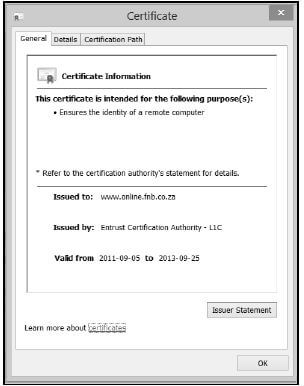
Which TWO pieces of information on the certificate can be used to verify that the website is legitimate? (2)
6.10.3 Staff members are often warned against social engineering.
- Explain what social engineering is. (2)
- What is a consequence of falling victim to social engineering? (1)
6.11 Green computing has become a focal point in the ICT field.
6.11.1 Define the term green computing. (1)
6.11.2 Suggest any TWO initiatives for the library to implement green computing. (2)
TOTAL SECTION F: 40
GRAND TOTAL: 150
INFORMATION TECHNOLOGY PAPER 1 GRADE 12 QUESTIONS - AMENDED SENIOR CERTIFICATE EXAMS PAST PAPERS AND MEMOS MAY/JUNE 2018
INFORMATION TECHNOLOGY
PAPER 1
GRADE 12
AMENDED SENIOR CERTIFICATE EXAMS
PAST PAPERS AND MEMOS
MAY/JUNE 2018
INSTRUCTIONS AND INFORMATION
- This question paper is divided into THREE sections. Candidates must answer ALL the questions in each of the THREE sections.
- The duration of this examination is three hours. Because of the nature of this examination it is important to note that you will not be permitted to leave the examination room before the end of the examination session.
- This question paper is set with programming terms that are specific to the Delphi programming language.
- Make sure that you answer the questions according to the specifications that are given in each question. Marks will be awarded according to the set requirements.
- Answer only what is asked in each question. For example, if the question does not ask for data validation, then no marks will be awarded for data validation.
- Your programs must be coded in such a way that they will work with any data and not just the sample data supplied or any data extracts that appear in the question paper.
- Routines, such as search, sort and selection must be developed from first principles. You may NOT use the built-in features of Delphi for any of these routines.
- All data structures must be defined by you, the programmer, unless the data structures are supplied.
- You must save your work regularly on the disk/CD/DVD/flash disk you have been given, or on the disk space allocated to you for this examination session.
- Make sure that your examination number appears as a comment in every program that you code, as well as on every event indicated.
- If required, print the programming code of all the programs/classes that you completed. You will be given half an hour printing time after the examination session.
- At the end of this examination session you must hand in a disk/CD/DVD/ flash disk with all your work saved on it OR you must make sure that all your work has been saved on the disk space allocated to you for this examination session. Ensure that all files can be read.
- The files that you need to complete this question paper have been given to you on the disk/CD/DVD/flash disk or on the disk space allocated to you. The files are provided in the form of password-protected executable files.
NOTE:
Candidates must use the file DataENGJune2018.exe.
Do the following:
- Double click on the password-protected executable file.
- Click on the extract button.
- Enter the following password: Bks18@Lib*#?
Once extracted, the following list of files will be available in the folder DataENGJune2018:
SUPPLIED FILES
Question1:
- Question1_P.dpr
- Question1_P.dproj
- Question1_P.res
- Question1_U.dfm
- Question1_U.pas
Question2:
- Book_U.pas
- BooksData.txt
- BooksDataBackup.txt
- Question2_P.dpr
- Question2_P.dproj
- Question2_P.res
- Question2_U.dfm
- Question2_U.pas
Question3:
- Question3_P.dpr
- Question3_P.dproj
- Question3_P.res
- Question3_U.dfm
- Question3_U.pas
QUESTIONS
SECTION A
QUESTION 1: GENERAL PROGRAMMING SKILLS
Do the following:
- Open the incomplete program in the Question1 folder.
- Enter your examination number as a comment in the first line of the Question1_U.pas file.
- Compile and execute the program. The GUI displays FIVE sections labelled QUESTION 1.1 to QUESTION 1.5. Currently the program has no functionality.
The following user interface is displayed: 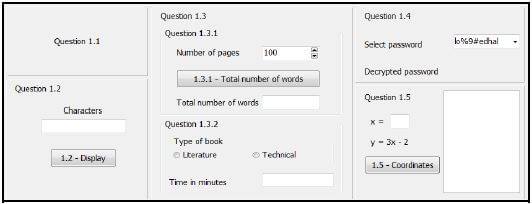
- Follow the instructions below to complete the code for EACH section of QUESTION 1, as described in QUESTION 1.1 to QUESTION 1.5.
1.1 OnCreate Event [Question 1.1]
Write code in the 'OnCreate' event handler of the Form to change the text displayed on the pnlQ1_1 panel as follows when the program is executed:
- Assign the existing text from the panel to a variable.
- Add a dash ('-') and use the relevant function to also add the system date to the text.
- Change the text to upper case and display the text in bold.
Example of output: ![]()
NOTE: The format of the system date may differ from the example. (6)
1.2 Button [1.2 - Display]
Write code using the loop counter variable cCounter and a loop to compile a string containing the letters 'Z' to 'R' in the variable sOutput. Assign the variable to the edit box to display.
Example of output: ![]() (6)
(6)
1.3 The time it takes a student to read a textbook depends on the total number of words the textbook contains and whether the content is of a technical nature or not.
1.3.1 Button [1.3.1 - Total number of words]
The average number of words per page in a textbook of standard size has been declared as 300 in a constant variable called WordsPerPage.
The user needs to select the number of pages the book contains from the spin edit component.
Complete the provided code to do the following:
- Declare an integer variable for the number of pages.
- Obtain the value of number of pages from the spin edit component.
- Use the constant variable and the number of pages to calculate the total number of words.
- Display the total number of words in the edit box provided.
NOTE: The variable iTotalNumWords has been declared as a global variable to be used again in QUESTION 1.3.2.
Example of output: 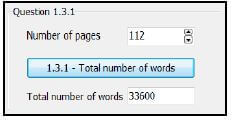 (5)
(5)
1.3.2 Radio group [1.3.2 – Type of book]
Research shows that a student can read a literature book at the speed of 250 words per minute and a technical book at the speed of 75 words per minute. These values have been declared as constant values using the variables WordsLit and WordsTech respectively. The user needs to select the type of book from the radio buttons provided.
Write code to do the following to determine the time it should take a student to read the book:
- Determine the type of book that has been selected.
- Use the global variable iTotalNumWords and the relevant constant variable to calculate the time (in minutes) it would take a student to read the book.
- Display the time in edit box edtTimeInMinutes provided.
NOTE: If you were not able to calculate the total number of pages in QUESTION 1.3.1, assign a value of 33 600 to the global variable iTotalNumWords to be able to do
QUESTION 1.3.2.
Example of output if the book is a technical book and has 112 pages, which results in 33 600 words, as calculated in QUESTION 1.3.1: 
Example of output if the book is a literature book and has 112 pages, which results in 33 600 words, as calculated in QUESTION 1.3.1: 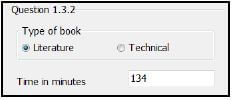 (7)
(7)
1.4 Combo box [cmbQ1_4]
The user needs to select a password from the combo box cmbQ1_4 which contains a number of encrypted passwords.
Write code to decrypt the selected password according to the instructions below.
- The first two characters of the password must be moved to the end of the password.
- If the password contains a hash character (#), replace it with a dollar character ($), followed by a full stop (.).
Example of output if the password os3%!ko has been selected: 
Example of output if the password ay7#@tod has been selected: (13)
(13)
1.5 Button [1.5 - Coordinates]
The formula for a straight line is y = mx + c. The formula must be used to calculate the value of the y-coordinate of the straight line if the value of x is entered by the user.
The values of 3 and -2 will be used as the values for m and c in the formula and has been assigned to the variables iM and iC respectively in the code provided. 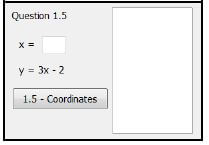
Write code to display the (x,y) coordinates of a straight line in the output area using the following instructions:
- Clear the output area.
- Display the heading 'Coordinates' followed by a blank line.
- Obtain the value of x that was entered from edit box edtQ1_5.
- Calculate the value of y using the formula y = mx + c.
Example of the calculation of y if the value 7 is entered for x:
y = mx + c
= 3(7) +(-2)
= 19
- Display the values of coordinates x and y in the output area in the format shown in the example below, for example (x,y) = (7,19) for the first coordinate.
- Decrease the value of x by 2 and repeat the previous two steps (calculate the value of y and display the coordinates) until the value of y is equal to zero (0) or is a negative value.
Example of output if the value of 7 was entered for the value of x: 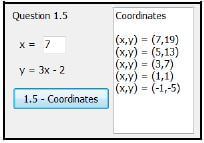
Example of output if the value of 12 was entered for the value of x: 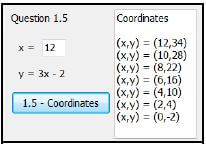 (13)
(13)
|
TOTAL SECTION A: 50
SECTION B
QUESTION 2: OBJECT-ORIENTATED PROGRAMMING
Students are allowed to borrow and return books in the research wing of the library during the week that they are working on their research projects. Data has been captured in a text file on the books that were borrowed and returned during a research week. The librarian needs to use the captured data to see how many copies of the books are available currently to allow books to be borrowed and returned during the next research week. |
Do the following:
- Open the incomplete project file called Question2_P.dpr in the Question2 folder. • Add your examination number as a comment in the first line of both the Question2_U.pas and Book_U.pas files.
- Compile and execute the program. Currently the program has limited functionality. The following GUI is displayed when the program is executed:

- Complete the code as described in QUESTION 2.1 and QUESTION 2.2 below.
2.1 Complete the code in the TBook object class provided, as described in QUESTION 2.1.1 to QUESTION 2.1.7 that follow.
2.1.1 Declare the attributes of the class using the information in the table below. (4)
NAMES OF ATTRIBUTES | DESCRIPTION |
fTitle | The title of the book |
fCatNum | A unique catalogue number assigned to each book in the library, e.g. D324.2 |
fNumBooks | An integer number that indicates the number of copies of this book that the library owns, e.g. 12 |
fNumBooksOut | An integer number that indicates the number of copies of this book that is currently borrowed, e.g. 5 |
2.1.2 Write code to create a constructor which receives THREE parameter values (the title, the catalogue number of the book and the number of copies of the book that the library owns) and initialises the relevant attributes using the parameter values. The attribute for the number of copies of the book out (currently borrowed) must be initialised to zero. (5)
2.1.3 Write an accessor method getCatalogueNumber for the catalogue number attribute of the book. (2)
2.1.4 Write an accessor method getNumBooksOut for the number of books out attribute. (2)
2.1.5 Write code for a mutator method setNumBooksOut to receive an integer as a parameter and set the fNumBooksOut attribute to the parameter value. (3)
2.1.6 Write code for a method called isBookAvailable that returns a Boolean value. This method must use the fNumBooks and fNumBooksOut attributes to determine whether a copy of the book is currently available in the library or not. The return value must be true if a book is available or false if not available. (3)
2.1.7 Write code to create a toString method to return a string formatted as follows:
The library owns < number of copies owned> copies of the book titled <book title> [<catalogue number>].
The number of copies currently out is <number of copies of the book currently borrowed>. (5)
Do the following to complete the code for Buttons 2.2.1, 2.2.2 and 2.2.3 in the main form unit, as described below.
2.2.1 Button [2.2.1 - Instantiate book object]
The user needs to select the catalogue number of the book from the combo box. Code has been provided to show the title and the number of copies of the selected book that the university owns in the relevant edit boxes.
Write code to do the following:
- Extract the required data items from the relevant components and instantiate a new objBook object.
- Call the toString method to display the details of the object in the output area provided.
- Activate the Update data button.
Example of output for the book if catalogue number G292.6 has been selected and the object has been instantiated: 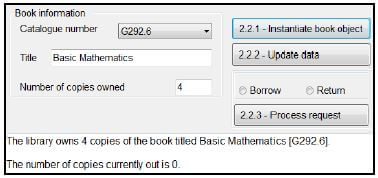
2.2.2 Button [2.2.2 - Update data]
A text file BooksData.txt contains the records of books that were borrowed and returned during a research week.
The data in the text file is saved in the following format:
<catalogue number of book>#<a character indicating whether the book was borrowed (B) or returned (R)>
Example of the first six lines of data in the BooksData.txt text file: 
The text file must be used to determine the number of copies of the selected book that were borrowed and returned during the research week. (8)
Write code to do the following:
- Test whether the text file BooksData.txt exists or not. Display a suitable message if the text file does not exist and exit the event handler.
- Do the following if the text file exists:
- Use a loop and search the text file for all instances of the catalogue number of the book object.
- Determine how many times the book has been borrowed (''B'') and returned (''R'') and use these values to determine the number of copies currently out of the library using the formula:
BooksOut = Number borrowed – Number returned - Call the setNumBooksOut method and use the BooksOut value as the argument.
- Call the toString method to display the updated details of the book object in the output area provided.
- Activate the Process request button.
Example of output for the Update data button if catalogue number G292.6 has been selected by the user and an object of this book has been instantiated: 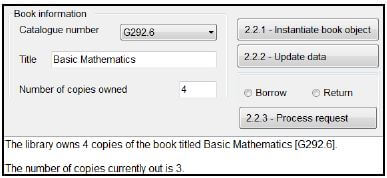 (20)
(20)
2.2.3 Button [2.2.3 - Process request]
Special requests to borrow books from the research wing can be granted if copies of the book are available. Students who did not return books that they borrowed during the research week are also allowed to return the books.
The radio group component must be used to select to either borrow or return the selected book. If the request to borrow or return the selected book has been granted, the text file BooksData and the object details of the book must be updated.
Write code for the following algorithm to process the borrow or return request for the selected book:
Set the provided sCode variable to an empty string Display a suitable message else Display a message to indicate there are no copies available If Return has been selected from the radio group If number of books out is 0 else Display a message indicating that the book has been returned If sCode contains data Write the catalogue number of the book and the value of sCode to the BooksData.txt text file in the correct format, e.g. G292.6#R |
NOTE: A Restore text file button has been provided that can be used to restore the content of the BooksData text file if the content of the BooksData text file becomes corrupted while testing your code. This will copy the data in the BooksDataBackup text file to the BooksData text file.
Example of output if a student requested to borrow the book titled Basic Mathematics if copies of this book are available to be borrowed: 
The following updated data should be displayed in the output area: 
Example of output if a student requested to borrow the book titled Basic Mathematics if no copy of this book is available to be borrowed:
Example of output if a student requested to return the book titled Basic Mathematics: 
The following updated data should be displayed in the output area: ![]()
Example of output if there is a request to return the book titled Coding in Objects with catalogue number C284.3. All the copies of this book have been returned. Therefore the request is invalid.  (18)
(18)
- Ensure that your examination number has been entered as a comment in the first line of the class file and the form.
- Save your program.
- Print the code contained in both the class file and form, if required.
TOTAL SECTION B: 70
SECTION C
QUESTION 3: PROBLEM-SOLVING PROGRAMMING
SCENARIO The university has three libraries. The first two libraries are open for six days of the week and the third library is open for five days of the week. There are six staff members who will be on duty in the libraries on the days the libraries are open. The manager of the library requires a program to create and maintain a placement schedule for staff members. |
Do the following:
- Compile and execute the program in the Question3 folder. Currently the program has no functionality.
- Complete the code for each section of the question as described in QUESTION 3.1 to QUESTION 3.3.
Supplied GUI:
The GUI below represents an interface used by the manager of the library to allocate duties shifts to staff members. 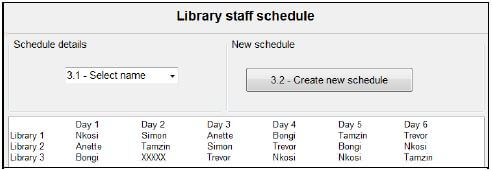
The following code has been provided:
- An array called arrStaff which contains the names of the six staff members.
arrStaff: array [1 .. 6] of String =
('Trevor','Nkosi','Tamzin','Anette','Bongi','Simon'); - The declaration of a two-dimensional array called arrPlacements that will be used to store the names of staff members according to the days they will be on duty (columns 1 to 6) in each library (rows 1 to 3):
arrPlacements: array [1 .. 3, 1 .. 6] of String =
(('Nkosi', 'Simon','Anette', 'Bongi', 'Tamzin', 'Trevor'),
('Anette', 'Tamzin','Simon', 'Trevor', 'Bongi', 'Nkosi'),
('Bongi', 'XXXXX', 'Trevor','Nkosi', 'Nkosi', 'Tamzin')); - A completed Display procedure that will display the schedule of staff placements (content of arrPlacements).
Example of the output of a schedule that will be displayed when the display procedure is called to display the content of arrPlacements. Library 3 can be closed on any day, as decided by the manager. For this schedule, the manager has decided to close Library 3 on Day 2, which is represented by 'XXXXX' in array arrPlacements. 
The row and column headings are not part of the content of the two-dimensional array provided.
NOTE:
- You are NOT allowed to modify supplied data manually. Code must be written to manipulate the supplied data according to the requirements.
- The use of good programming techniques and modular design must be applied in the design and coding of your solution.
- NO marks will be awarded for the use of hardcoding to populate array arrPlacements.
3.1 Combo box [3.1 - Select name]
A staff member may request a schedule of his/her duties.
When a name is selected from the combo box cmbStaff, the following information must be displayed in the output component provided:
- A heading with the name of the staff member
- The work schedule details of the selected staff member
The format of the work schedule details is as follows:
Day <day number>-Library#<library number>
Example of output if staff member Tamzin was selected from cmbStaff: 
Example of output if staff member Nkosi was selected from cmbStaff:  (10)
(10)
3.2 Button [3.2 - Create new schedule]
A one-dimensional array called arrStaff is provided and must be used to create a new schedule for staff members. The new schedule must be saved in the two-dimensional array arrPlacements.
Write code to compile a new placement schedule for staff members by populating the arrPlacements array with the names of staff members as follows:
Library 1: Each staff member will be placed on duty according to the order of the appearance of their names in the array arrStaff. The first staff member in the array will be assigned to Day 1, the second staff member to Day 2 and so on. 
Library 2: Each staff member will be placed on duty in the reverse order of the contents of the array arrStaff. The first staff member in the array will be assigned to Day 6, the second staff member to Day 5 and so on: 
Library 3: Write code to use an input box to prompt the manager to enter a day number (1 to 6) on which Library 3 will be closed. Array arrPlacements must show 'XXXXX' for the day the library is closed. The staff will be allocated randomly for the remainder of the days to this library. A test must be done to ensure that the staff member randomly selected for Library 3 is not already allocated to Library 1 or Library 2 for that day.
Example of output if the manager entered Day 3 for Library 3 to be closed:  (20)
(20)
|
TOTAL SECTION C: 30
GRAND TOTAL: 150
INFORMATION TECHNOLOGY PAPER 1 GRADE 12 MEMORANDUM - AMENDED SENIOR CERTIFICATE EXAMS PAST PAPERS AND MEMOS MAY/JUNE 2018
INFORMATION TECHNOLOGY
PAPER 1
GRADE 12
AMENDED SENIOR CERTIFICATE EXAMS
PAST PAPERS AND MEMOS
MAY/JUNE 2018
GENERAL INFORMATION:
- These marking guidelines must be used as the basis for the marking session. They were prepared for use by markers. All markers are required to attend a rigorous standardisation meeting to ensure that the guidelines are consistently interpreted and applied in the marking of candidates' work.
- Note that learners who provide an alternate correct solution to that given as example of a solution in the marking guidelines will be given full credit for the relevant solution, unless the specific instructions in the question paper were not followed or the requirements of the question were not met.
- Annexures A, B and C (pages 3–9) include the marking grid for each question and a table for a summary of the learner’s marks.
- Annexures D,E and F (pages 10–20) contain examples of a programming solution for QUESTION 1 to QUESTION 3 in programming code.
- Copies of Annexures A, B, C and the summary of learner’s marks (pages 3–9) should be made for each learner and completed during the marking session.
MEMORANDUM
ANNEXURE A
SECTION A
QUESTION 1: MARKING GRID – GENERAL PROGRAMMING SKILLS
CENTRENUMBER: | EXAMINATION NUMBER: | |||
QUESTION | DESCRIPTION | MAX. MARKS | LEARNER'S MARKS | |
A learner must be penalised only once if the same error is repeated. | ||||
1.1 | Form [OnCreate event] | 6 | ||
1.2 | Button [1.2 – Display] | 6 | ||
1.3.1 | Button [1.3.1 – Total number of words] | 5 | ||
1.3.2 | Radiogroup [1.3.2 – Type of book] | 7 | ||
1.4 | Combo box [cmbQ1_4] | 13 | ||
1.5 | Button [1.5 – Coordinates] | 13 | |
TOTAL SECTION A: | 50 |
ANNEXURE B
SECTION B
QUESTION 2: MARKING GRID – OBJECT ORIENTED PROGRAMMING
CENTRE NUMBER: | EXAMINATION NUMBER: | |||
QUESTION | DESCRIPTION A learner must be penalised only once if the same error is repeated. | MAX. MARKS | LEARNER' S MARKS | |
2.1.1 | Declare attributes
| 4 | ||
2.1.2 | CONSTRUCTOR
| 5 | ||
2.1.3 | METHOD – getCatalogueNumber
| 2 | ||
2.1.4 | METHOD – getNumBooksOut
| 2 | ||
2.1.5 | METHOD – setNumBooksOut
| 3 | ||
2.1.6 | METHOD – isBookAvailable
| 3 | ||
2.1.7 | METHOD – toString
| 5 | |
2.2.1 | Button [2.2.1– Instantiate book object]
| 8 | |
2.2.2 | Button [2.2.2 – Update data]
IF the BooksData file exists:
| 20 | |
2.2.3 | Button [2.2.3 – Borrow book]
Else Else Else
Test if sCode is not an empty string ✔ | 18 | |
TOTAL SECTION B | 70 |
ANNEXURE C
SECTION C
QUESTION 3: MARKING GRID – PROBLEM SOLVING
QUESTION | DESCRIPTION | MAX. MARKS | LEARNER' S MARKS |
3.1 | Combo box [3.1 – Select name] | 10 | |
3.2 | Button [3.2 – Create new schedule] | 20 | |
TOTAL | 30 |
SUMMARY OF LEARNER'S MARKS:
CENTRE NUMBER: | EXAMINATION NUMBER: |
SECTION A | SECTION B | SECTION C | ||
QUESTION 1 | QUESTION 2 | QUESTION 3 | GRAND TOTAL | |
MAX. MARKS | 50 | 70 | 30 | 150 |
LEARNER'S MARKS |
ANNEXURE D: SOLUTION FOR QUESTION 1



ANNEXURE E: SOLUTION FOR QUESTION 2
OBJECT CLASS


MAIN FORM UNIT: QUESTION2-U.PAS



ANNEXURE F: SOLUTION FOR QUESTION 3



INFORMATION TECHNOLOGY PAPER 2 GRADE 12 MEMORANDUM - AMENDED SENIOR CERTIFICATE EXAMS PAST PAPERS AND MEMOS MAY/JUNE 2018
INFORMATION TECHNOLOGY
PAPER 2
GRADE 12
AMENDED SENIOR CERTIFICATE EXAMS
PAST PAPERS AND MEMOS
MAY/JUNE 2018
MEMORANDUM
SECTION A: SHORT QUESTIONS
QUESTION 1
1.1
1.1.1 C ✔ (1)
1.1.2 D ✔ (1)
1.1.3 D ✔ (1)
1.2
1.2.1 C ✔✔ (2)
1.2.2 B ✔✔ (2)
1.3
1.3.1 RIA (Rich Internet Applications) ✔ (1)
1.3.2 Decision Support System(DSS) ✔ (1)
1.3.3 Adware ✔ (1)
1.3.4 Botnet ✔ (1)
1.3.5 CMOS ✔ (1)
1.3.6 Data verification ✔ (1)
1.3.7 Black hat hacker/cracker ✔ (1)
1.3.8 Point of Sale (POS) system ✔ (1)
1.3.9 Spam ✔ (1)
TOTAL SECTION A: 16
SECTION B: SYSTEM TECHNOLOGIES
QUESTION 2
2.1
2.1.1 The motherboard is made up of separate components ✔ (1)
2.1.2 Any ONE ✔
- Keyboard
- Mouse
- Monitor
- Network cable
- Sound cable/Speaker (1)
2.1.3 To hold the data and instructions being processed✔ (1)
2.1.4 Cache memory is high speed memory that holds data and instructions likely to be used next by the CPU and so speeds up the processing by speeding up access to data and instructions stored on a slower medium.
Concepts:
- ✔ High speed memory
- ✔ Stores data and instructions likely to be used/recently used
- ✔ Don't have to wait for slower medium/fetch from slower medium (3)
2.1.5 Multiprocessing:
- Multiple cores ✔ are used to run multiple programs/threads simultaneously ✔ (2)
2.2
2.2.1 Any TWO reasons for preferring mobile devices: ✔✔
- Always on functionality
- Availability of communication
- Convergent
- Powerful/speed
Also accept: Any other suitable reason/example (2)
2.2.2 Any TWO limiting factors of using mobile devices: ✔✔
- Limited battery life
- Small screen size
- Difficulty typing on small virtual keyboard
- Limited storage capacity (2)
2.2.3 Any TWO reasons for using SSDs instead of HDDs: ✔✔
- No moving parts that can be damaged in mobile environment/More robust
- Faster at boot time/Faster data transfer rate
- Smaller dimensions to fit into small devices
- Lower power usage to save power (2)
2.3
2.3.1 Any ONE explanation of Cloud application:✔
- The processing of the software is done on servers on the Internet
OR - An application that resides on the Internet and not on a local computer (1)
2.3.2 Any TWO reasons for using SaaS: ✔✔
- Software is rented not bought/Cheaper as do not have to buy/pay for updates/updating software
- Always have access to latest version of software
- Can use software on a number of devices/Can open programs in any browser
- Get limited free cloud storage (2)
2.3.3 Any ONE disadvantage of cloud computing: ✔
- The service provider could go out of business
- Security issues
- Still need a good backup policy
- Slow access upload/download problems (1)
2.3.4 Virtualisation
- Splitting the resources of powerful machines between multiple users ✔
- Combining resources of many machines into one powerful machine ✔ (2)
2.4
2.4.1 Online digital media repository:
- Online storage location ✔ used exclusively for digital content such as music and videos (1)
2.4.2 Any TWO reasons for using a media repository: ✔✔
- Centralised data/easy access
- Saves on local device storage space (2)
2.5 Any ONE reason for using online backup: ✔
- To have a copy of the data off-site
- To back up data in case disaster strikes (1)
TOTAL SECTION B: 24
SECTION C: COMMUNICATION AND NETWORK TECHNOLOGIES
QUESTION 3
3.1
3.1.1 Any ONE ✔
- Portability and mobility/a user can connect via a laptop or other device/Access to network from a wider range
- A device can be added to the network easily
- Cost effective by saving on data costs (1)
3.1.2 Any ONE✔
- Provides a unique address for communication
- To prevent conflicts in addresses during communication (1)
3.1.3 Any TWO ✔✔
- Too far away from the router
- Too many users are accessing at the same time/Lack of sufficient bandwidth
- Interferences like EMI
- Interferences by structures like trees/buildings (2)
3.2
3.2.1 Any TWO ✔✔
- Secure web hosting
- Spam filtering (2)
3.2.2 Any TWO ✔✔
- High speed/permanent connection
- Allows for internet access and telephone use at the same time
- Relatively cheap when using a lot of data
- Scalability (2)
3.2.3 Connects devices to one another ✔ and directs traffic between devices. ✔ (2)
3.2.4(a) Any ONE ✔
- Glass fibers
- Light
- Laser (1)
3.2.4(b) Any TWO ✔✔
- Less interference/less EMI
- Secure and difficult to tap/No eavesdropping
- Very fast speed
- Can cover larger distances without regeneration (2)
3.3
3.3.1 Any ONE ✔
A thin client has:
- No hard drive
- Limited hardware resources (1)
3.3.2 Any TWO ✔✔
- Software will only need to be installed on the server
- Save on cost due to lower specifications of clients
- Space saving due to smaller dimensions (2)
3.3.3 Any ONE ✔
- Provides power for a short while if there is a power failure
- Provides power to have sufficient time to shut down the server properly (1)
3.4
3.4.1
- The staff can work with resources away from the business premises/offices at any part of the day or night ✔
OR - Can remotely access the business network with the same security as a local connection (1)
3.4.2 Encryption ✔ (1)
3.4.3 Any TWO ✔✔
- Firewall blocking
- VPN security details entered incorrectly/Incorrect password
- No Internet access
- Not registered as a user on the VPN
- Incorrect VPN software configuration (2)
3.5 Scalability ✔ (1)
TOTAL SECTION C: 22
SECTION D: DATA AND INFORMATION MANAGEMENT
QUESTION 4
4.1
4.1.1 Relational database is a database consisting of different tables✔ which are linked with relationships✔ (2)
4.1.2 Any ONE ✔✔
Record locking is required:
- To prevent changes made by one of the staff members from being lost
- If the record is locked only one user may be allowed to make changes to the content of the record.
- Accessing the same record at the same time can corrupt data
- Anomalies may occur- data should stay consistent (2)
4.1.3 Any TWO responsibilities of database administrator ✔✔
(excluding planning and creating database)
- Setup user accounts and user rights
- Setup backup strategy for database
- Create queries for users of the database
- Monitor the working of the database (2)
4.2
4.2.1 It refers to a field/s that makes possible that the record can be uniquely identified. ✔ (1)
4.2.2 Foreign key✔ (1)
4.2.3 It means that the primary key can consist of more than one field. ✔ (1)
4.2.4
- One to many relationship ✔
- One student can borrow many books ✔ (2)
4.2.5 Any ONE ✔✔
- A record on the one (tblStudents) side of the relationship cannot be deleted if it is linked to records on the many (tblBooksBorrowed) side of the relationship.
OR - A new record cannot be entered on the many (tblBooksBorrowed) side of a table without a corresponding record on the one (tblStudents) side of the relationship. (2)
4.2.6 (a) SELECT StudentName, StudentSurname, FundsAvailable
FROM tblStudents WHERE FundsAvailable <= 30
- ✔ Select with 3 correct fields -StudentName
StudentSurname, FundsAvailable - ✔FROM tblStudents
- ✔WHERE FundsAvailable <= 30 (3)
(b) SELECT tblStudents.StudentNumber, Count(ISBN) AS
NumberBorrowed FROM tblStudents, tblBooksBorrowed
WHERE tblStudents.StudentNumber =
tblBooksBorrowed.StudentNumber GROUP BY
tblStudents.StudentNumber HAVING (NumberBorrowed > 2)
- ✔SELECT tblStudents.StudentNumber
- ✔Count(ISBN)
- ✔AS NumberBorrowed
- ✔FROM tblStudents, tblBooksBorrowed
- ✔WHERE tblStudents.StudentNumber =
tblBooksBorrowed.StudentNumber - ✔GROUP BY tblStudents.StudentNumber
- ✔HAVING (NumberBorrowed > 2) (7)
TOTAL SECTION D: 23
SECTION E: SOLUTION DEVELOPMENT
QUESTION 5
5.1
5.1.1 Code to be executed when the application starts/when program opens/runs ✔ (1)
5.1.2 Any ONE: ✔
- The number of repetitions is unknown
- The number of repetitions is dependent on the condition (1)
5.1.3 To determine the ASCII/ordinal value of a character ✔ (1)
5.2
5.2.1
- When a class/unit keeps/declares its variables private ✔ so it cannot be accessed from outside the class/unit ✔
OR
Details of attributes are hidden and not directly available/accessible outside the class/unit (2) - Any ONE: ✔
- DateTime
- String
- Date (1)
- +getStudentCode:String ✔ (1)
- +setLoginNumber(iLoginNumber:integer) ✔ (1)
- Auxiliary/formatting ✔ method (1)
5.2.2
- Linear/sequential ✔ (1)
- Any ONE: ✔
- Provide for testing uppercase and lowercase characters
- Avoid using fixed values such as 1000/Can only be used for 1000 students and more
- Search continues even after record has been found (1)
- bFound ?false ✔
iPos?1 ✔
while bFound = false ✔ AND iPos <= length of array ✔
if arrStudNumbers[iPos] =sSearch ✔
arrMathResults[iPos] = new mark input✔
bFound ?true✔
increase iPos✔ (8)
5.3
sName | NOT(Upcase(sN ame[A]) in ['A','E','I','O','U']) | sCode | A | Is sName[A] = ' '? | Display |
Mark Simon | '' | 1 | |||
True | |||||
M | |||||
2 | |||||
False | |||||
False✔ | |||||
3✔ | |||||
False✔ | |||||
True✔ | |||||
Mr✔ | |||||
4✔ | |||||
False✔ | |||||
True✔ | |||||
Mrk✔ | |||||
5✔ | |||||
True✔ | |||||
Mrk✔ |
(12/2 =6)
TOTAL SECTION E: 25
SECTION F: INTEGRATED SCENARIO
QUESTION 6
6.1
6.1.1 Acceptable Use Policy ✔ (1)
6.1.2 To provide the user of a network environment with the rights and responsibilities ✔ when using their ICT resources/network ✔ (2)
6.2 File syncing:
- Ensure that all devices ✔ contain the most up to date version of the same document ✔ (2)
6.3
6.3.1 Any TWO skills: ✔✔
- Software programming skills
- Graphic design skills
- Knowledge on HCI principles
- Creativity and imagination
- Knowledge on advances in technology (2)
6.3.2 Any TWO factors: ✔✔
- Page must automatically resize/provide for smaller screens
- Different format and page layout/readability
- Reduced size of image files/less data to download
- Exclude certain content/functionality/flash players
- Work cross platform
- Limitations in terms of processing and storage on smaller devices (2)
6.4
6.4.1 Any ONE definition of metadata: ✔
- Additional data/information on the video that is saved with the file
- Data about data (1)
6.4.2 Any ONE ✔
- MPEG-2
- MPEG-4
- .MP4
- .avi
- MKV
Also accept any other acceptable compression format (1)
6.5
6.5.1 Online seminars ✔ (1)
6.5.2 Any ONE ✔
- Make use of RSS feeds
- Suitable apps
- Message alerts/SMS (1)
6.6
6.6.1 Any THREE functions of an operating system: ✔✔✔
- Provides an interface
- Manages processes and tasks
- Manages memory
- Manages input and output
- Manages the disk/s (3)
6.6.2 Any ONE advantage of using proprietary operating system: ✔
- Formal support in terms of help is available/The company owning the operating system supplies a help desk
- Patches/service packs are released with updates which are made available to everyone (1)
6.7
6.7.1 Radio Frequency Identification✔ (1)
6.7.2
- Passive tags receive all the power they need from the RFID reader✔and they can only start interacting with the reader once they enter the electromagnetic field generated by the reader. ✔
- Active tags receive their power from on-board batteries, which allow them to communicate over longer distances/constant communication. ✔ (3)
6.7.3 Any TWO ✔✔
- Prone to mistakes (human errors)
- Time consuming
- Cost incurred with hiring of personnel (2)
6.8 Netiquette describes behaviour when sending e-mails or any form of electronic communication ✔
(Any ONE acceptable example ✔)
- You should not advertise products using e-mail
- Do not send lengthy e-mails
- Do not attach very large documents to your e-mail
- Avoid spelling errors
- Do not take part in flame wars
- Do not forward spam/hoaxes
- Do not use only capital letters
NOTE:
Do not accept general comments – the example must be linked to electronic communication. (2)
6.9 Any ONE ✔
- People often aspire to what seems to be the more popular, common and desirable culture and so discard their own.
- Often people gravitate to what looks to be the more sophisticated and appealing cultures and abandon their own traditions, languages and lifestyles.
- Any other acceptable answer (1)
6.10
6.10.1
- Encryption is the scrambling of text/data into a new format✔ using a specified set of rules ✔ (2)
- Public key encryption:
- A public key is transmitted to user/client. ✔
- Message is encrypted with public key ✔
- Message can only be decrypted with private key that is kept by the receiver.✔ (3)
6.10.2
- The URL contains https: ✔ (1)
- Any TWO ✔✔
- The certificate is provided by a third party company like VeriSign
- It is linked to a specific web address, confirming its validity
- Date of validity (2)
6.10.3
- Social engineering refers to 'conning' or tricking ✔ a person into willingly ✔ giving out personal information. (2)
- Sensitive information such as passwords or other information that can be used to commit identity theft.✔
Or any other sensible/realistic consequence (1)
6.11
6.11.1 Initiatives to design, use and dispose of technology in an environmentally or eco-friendly way. (1)
6.11.2 Any TWO ✔✔
- Store records electronically – use less paper
- Scan research from books rather than copying
- Switch computers off when not in use
- Set computers to sleep mode (2)
TOTAL SECTION F: 40
GRAND TOTAL: 150
